Samsung Electronics Co SMT217A Multi-Band WCDMA/ LTE Portable Tablet with WLAN and Bluetooth User Manual SM T210
Samsung Electronics Co Ltd Multi-Band WCDMA/ LTE Portable Tablet with WLAN and Bluetooth SM T210
Contents
- 1. Users Manual 1
- 2. Users Manual 2
Users Manual 1
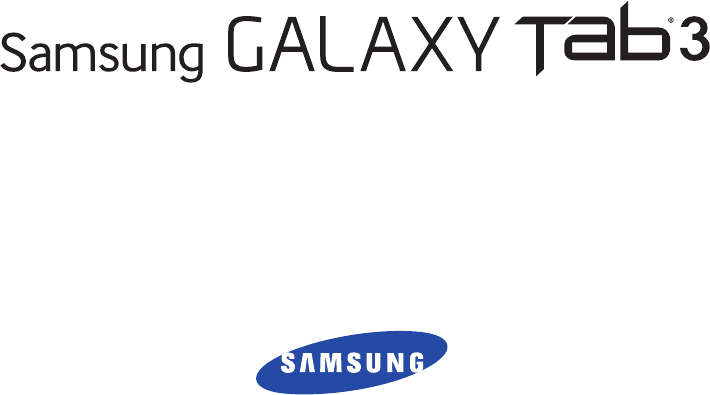
ANDROID TABLET
User Manual
Please read this manual before operating your
device and keep it for future reference.

SM-T217A_UM_English_xx_xx_072313_D0
Intellectual Property
All Intellectual Property, as defined below, owned by or which is otherwise the property of Samsung or its respective suppliers
relating to the SAMSUNG Galaxy Tab, including but not limited to, accessories, parts, or software relating there to (the “Galaxy Tab
System”), is proprietary to Samsung and protected under federal laws, state laws, and international treaty provisions. Intellectual
Property includes, but is not limited to, inventions (patentable or unpatentable), patents, trade secrets, copyrights, software,
computer programs, and related documentation and other works of authorship. You may not infringe or otherwise violate the
rights secured by the Intellectual Property. Moreover, you agree that you will not (and will not attempt to) modify, prepare
derivative works of, reverse engineer, decompile, disassemble, or otherwise attempt to create source code from the software. No
title to or ownership in the Intellectual Property is transferred to you. All applicable rights of the Intellectual Property shall remain
with SAMSUNG and its suppliers.
Open Source Software
Some software components of this product incorporate source code covered under GNU General Public License (GPL), GNU Lesser
General Public License (LGPL), OpenSSL License, BSD License and other open source licenses. To obtain the source code covered
under the open source licenses, please visit:
http://opensource.samsung.com
.
Disclaimer of Warranties; Exclusion of Liability
EXCEPT AS SET FORTH IN THE EXPRESS WARRANTY CONTAINED ON THE WARRANTY PAGE ENCLOSED WITH THE PRODUCT, THE
PURCHASER TAKES THE PRODUCT "AS IS", AND SAMSUNG MAKES NO EXPRESS OR IMPLIED WARRANTY OF ANY KIND
WHATSOEVER WITH RESPECT TO THE PRODUCT, INCLUDING BUT NOT LIMITED TO THE MERCHANTABILITY OF THE PRODUCT OR
ITS FITNESS FOR ANY PARTICULAR PURPOSE OR USE; THE DESIGN, CONDITION OR QUALITY OF THE PRODUCT; THE
PERFORMANCE OF THE PRODUCT; THE WORKMANSHIP OF THE PRODUCT OR THE COMPONENTS CONTAINED THEREIN; OR
COMPLIANCE OF THE PRODUCT WITH THE REQUIREMENTS OF ANY LAW, RULE, SPECIFICATION OR CONTRACT PERTAINING

THERETO. NOTHING CONTAINED IN THE INSTRUCTION MANUAL SHALL BE CONSTRUED TO CREATE AN EXPRESS OR IMPLIED
WARRANTY OF ANY KIND WHATSOEVER WITH RESPECT TO THE PRODUCT. IN ADDITION, SAMSUNG SHALL NOT BE LIABLE FOR
ANY DAMAGES OF ANY KIND RESULTING FROM THE PURCHASE OR USE OF THE PRODUCT OR ARISING FROM THE BREACH OF
THE EXPRESS WARRANTY, INCLUDING INCIDENTAL, SPECIAL OR CONSEQUENTIAL DAMAGES, OR LOSS OF ANTICIPATED PROFITS
OR BENEFITS.
Modification of Software
SAMSUNG IS NOT LIABLE FOR PERFORMANCE ISSUES OR INCOMPATIBILITIES CAUSED BY YOUR EDITING OF REGISTRY SETTINGS,
OR YOUR MODIFICATION OF OPERATING SYSTEM SOFTWARE.
USING CUSTOM OPERATING SYSTEM SOFTWARE MAY CAUSE YOUR DEVICE AND APPLICATIONS TO WORK IMPROPERLY. YOUR
CARRIER MAY NOT PERMIT USERS TO DOWNLOAD CERTAIN SOFTWARE, SUCH AS CUSTOM OS.
Samsung Electronics America (SEA), Inc
Address:
85 Challenger Road
Ridgefield Park,
New Jersey
07660
Toll Free
Telephone:
1-800-SAMSUNG
Internet
Address:
http://www.samsung.com

©2013 Samsung Electronics America, Inc. All rights reserved.
Do you have questions about your Samsung Mobile Device?
For 24 hour information and assistance, we offer a new FAQ/ARS System (Automated Response System) at:
www.samsung.com/us/support
Nuance®, VSuite™, T9® Text Input, XT9® Smart Input, and the Nuance logo are trademarks or registered trademarks of Nuance
Communications, Inc., or its affiliates in the United States and/or other countries.
The Bluetooth® word mark, figure mark (stylized “B Design”), and combination mark (Bluetooth word mark and “B Design”) are
registered trademarks and are wholly owned by the Bluetooth SIG.
microSDTM, microSDHCTM, and the microSD logo are Trademarks of the SD Card Association.
Google, the Google logo, Android, the Android logo, Google Play, Gmail, Google Latitude, Google Local, Google Maps, Google Play
Books, Google Play Magazines, Google Play Movies & TV, Google Play Music, Google Talk, Picasa, and YouTube and other marks
are trademarks of Google Inc.
Wi-Fi is a registered trademark of the Wireless Fidelity Alliance, Inc.
Peel and the Peel logo are marks owned by Peel Technologies, Inc. and may be registered.
Polaris Office and the Polaris Office logo are marks owned by Infraware and may be trademarks or registered trademarks.

DivX®, DivX Certified® and associated logos are trademarks of Rovi Corporation or its subsidiaries and are used under license.
DivX Certified® to play DivX® video up to HD 720p, including premium content.
ABOUT DIVX VIDEO: DivX® is a digital video format created by DivX, LLC, a subsidiary of Rovi Corporation. This is an official DivX
Certified® device that plays DivX video. Visit
www.divx.com
for more information and software tools to convert your files into DivX
videos.
ABOUT DIVX VIDEO-ON-DEMAND: This DivX Certified® device must be registered in order to play purchased DivX Video-on-
Demand (VOD) movies. To obtain your registration code, locate the DivX VOD section in your device setup menu (
Apps > Settings >
About device > Legal information > License settings > DivX® VOD > Register
). Go to
vod.divx.com
for more information on how to
complete your registration.

1
Table of Contents
Section 1: Getting Started ...........................5
Understanding This User Manual . . . . . . . . . . . . 5
Battery . . . . . . . . . . . . . . . . . . . . . . . . . . . . . . . 6
Turning Your Device On and Off . . . . . . . . . . . . . 8
Setting Up Your Device . . . . . . . . . . . . . . . . . . . 8
Creating a New Google Account . . . . . . . . . . . 12
Retrieving Your Google Account Password . . . . 12
Using Google Maps . . . . . . . . . . . . . . . . . . . . . 12
Task Manager . . . . . . . . . . . . . . . . . . . . . . . . . 13
Memory Card . . . . . . . . . . . . . . . . . . . . . . . . . 13
Galaxy Tab Accessories . . . . . . . . . . . . . . . . . . 15
Securing Your Device . . . . . . . . . . . . . . . . . . . 15
Troubleshooting . . . . . . . . . . . . . . . . . . . . . . . 16
Section 2: Understanding Your Device .....17
Features . . . . . . . . . . . . . . . . . . . . . . . . . . . . . 17
Front View . . . . . . . . . . . . . . . . . . . . . . . . . . . . 18
Home Screen . . . . . . . . . . . . . . . . . . . . . . . . . 20
Navigating Your Device . . . . . . . . . . . . . . . . . . 23
Notifications . . . . . . . . . . . . . . . . . . . . . . . . . . 24
Status Details . . . . . . . . . . . . . . . . . . . . . . . . . 24
Quick Settings . . . . . . . . . . . . . . . . . . . . . . . . . 25
Status Bar . . . . . . . . . . . . . . . . . . . . . . . . . . . .28
Primary Shortcuts . . . . . . . . . . . . . . . . . . . . . .29
Other App Shortcuts . . . . . . . . . . . . . . . . . . . .29
Widgets . . . . . . . . . . . . . . . . . . . . . . . . . . . . . .29
App Shortcuts . . . . . . . . . . . . . . . . . . . . . . . . .30
Folders . . . . . . . . . . . . . . . . . . . . . . . . . . . . . .31
Wallpapers . . . . . . . . . . . . . . . . . . . . . . . . . . .32
Apps Screen . . . . . . . . . . . . . . . . . . . . . . . . . .32
Entering Text . . . . . . . . . . . . . . . . . . . . . . . . . .34
Using Google Voice Typing . . . . . . . . . . . . . . . .38
Section 3: Contacts and Accounts ...........39
Accounts . . . . . . . . . . . . . . . . . . . . . . . . . . . . .39
Contacts . . . . . . . . . . . . . . . . . . . . . . . . . . . . .40
Groups . . . . . . . . . . . . . . . . . . . . . . . . . . . . . . .44
Favorites . . . . . . . . . . . . . . . . . . . . . . . . . . . . .46
Section 4: Messaging ...............................47
Types of Messages . . . . . . . . . . . . . . . . . . . . .47
Gmail . . . . . . . . . . . . . . . . . . . . . . . . . . . . . . . .47
Email . . . . . . . . . . . . . . . . . . . . . . . . . . . . . . . .48
Google Talk . . . . . . . . . . . . . . . . . . . . . . . . . . .51
Google+ . . . . . . . . . . . . . . . . . . . . . . . . . . . . .52
2
Messenger . . . . . . . . . . . . . . . . . . . . . . . . . . . 52
ChatON . . . . . . . . . . . . . . . . . . . . . . . . . . . . . 53
Section 5: Internet and Social
Networking ............................................. 54
Google Search . . . . . . . . . . . . . . . . . . . . . . . . 54
Google+ . . . . . . . . . . . . . . . . . . . . . . . . . . . . . 55
Internet . . . . . . . . . . . . . . . . . . . . . . . . . . . . . 55
Local . . . . . . . . . . . . . . . . . . . . . . . . . . . . . . . 57
Maps . . . . . . . . . . . . . . . . . . . . . . . . . . . . . . . 58
Navigation . . . . . . . . . . . . . . . . . . . . . . . . . . . 59
Play Books . . . . . . . . . . . . . . . . . . . . . . . . . . . 59
Play Magazines . . . . . . . . . . . . . . . . . . . . . . . 60
YouTube . . . . . . . . . . . . . . . . . . . . . . . . . . . . 60
Section 6: Music ....................................... 61
Listening to Music . . . . . . . . . . . . . . . . . . . . . 61
Play Music App . . . . . . . . . . . . . . . . . . . . . . . 61
Music Player . . . . . . . . . . . . . . . . . . . . . . . . . 64
Section 7: Photos and Video .................... 69
Camera . . . . . . . . . . . . . . . . . . . . . . . . . . . . . 69
Camcorder . . . . . . . . . . . . . . . . . . . . . . . . . . . 73
Video Player . . . . . . . . . . . . . . . . . . . . . . . . . . 77
Gallery . . . . . . . . . . . . . . . . . . . . . . . . . . . . . . 79
Section 8: Connections .............................84
Wi-Fi . . . . . . . . . . . . . . . . . . . . . . . . . . . . . . . 84
Wi-Fi Direct . . . . . . . . . . . . . . . . . . . . . . . . . . 86
Bluetooth . . . . . . . . . . . . . . . . . . . . . . . . . . . . 87
Managing Downloads . . . . . . . . . . . . . . . . . . . 89
Kies Via Wi-Fi . . . . . . . . . . . . . . . . . . . . . . . . . 91
Memory Card . . . . . . . . . . . . . . . . . . . . . . . . . 92
Synchronizing with Windows Media Player . . . 93
Connecting as a Mass Storage Device . . . . . . 93
Section 9: Applications .............................94
Updating Applications . . . . . . . . . . . . . . . . . . . 94
GPS Applications . . . . . . . . . . . . . . . . . . . . . . 94
Accessing Applications . . . . . . . . . . . . . . . . . . 95
Alarm . . . . . . . . . . . . . . . . . . . . . . . . . . . . . . . 95
Calculator . . . . . . . . . . . . . . . . . . . . . . . . . . . . 97
Camera . . . . . . . . . . . . . . . . . . . . . . . . . . . . . 97
ChatON . . . . . . . . . . . . . . . . . . . . . . . . . . . . . 97
Chrome . . . . . . . . . . . . . . . . . . . . . . . . . . . . . 97
Contacts . . . . . . . . . . . . . . . . . . . . . . . . . . . . . 98
Downloads . . . . . . . . . . . . . . . . . . . . . . . . . . . 98
Dropbox . . . . . . . . . . . . . . . . . . . . . . . . . . . . . 98
Email . . . . . . . . . . . . . . . . . . . . . . . . . . . . . . . 99
Flipboard . . . . . . . . . . . . . . . . . . . . . . . . . . . . 99
Gallery . . . . . . . . . . . . . . . . . . . . . . . . . . . . . 100
3
Game Hub . . . . . . . . . . . . . . . . . . . . . . . . . . . 100
Gmail . . . . . . . . . . . . . . . . . . . . . . . . . . . . . . 100
Google . . . . . . . . . . . . . . . . . . . . . . . . . . . . . . 100
Google Settings . . . . . . . . . . . . . . . . . . . . . . .100
Google+ . . . . . . . . . . . . . . . . . . . . . . . . . . . .101
Group Play . . . . . . . . . . . . . . . . . . . . . . . . . . 101
Help . . . . . . . . . . . . . . . . . . . . . . . . . . . . . . . 102
Internet . . . . . . . . . . . . . . . . . . . . . . . . . . . . . 102
Local . . . . . . . . . . . . . . . . . . . . . . . . . . . . . . . 102
Maps . . . . . . . . . . . . . . . . . . . . . . . . . . . . . . . 103
Memo . . . . . . . . . . . . . . . . . . . . . . . . . . . . . . 103
Messenger . . . . . . . . . . . . . . . . . . . . . . . . . . 104
Music Hub . . . . . . . . . . . . . . . . . . . . . . . . . . . 104
Music Player . . . . . . . . . . . . . . . . . . . . . . . . . 104
My Files . . . . . . . . . . . . . . . . . . . . . . . . . . . . 104
Navigation . . . . . . . . . . . . . . . . . . . . . . . . . . . 105
Play Books . . . . . . . . . . . . . . . . . . . . . . . . . . 105
Play Magazines . . . . . . . . . . . . . . . . . . . . . . .105
Play Movies & TV . . . . . . . . . . . . . . . . . . . . . . 106
Play Music . . . . . . . . . . . . . . . . . . . . . . . . . . 106
Play Store . . . . . . . . . . . . . . . . . . . . . . . . . . . 106
Polaris Office . . . . . . . . . . . . . . . . . . . . . . . . . 107
S Planner . . . . . . . . . . . . . . . . . . . . . . . . . . . 108
S Voice . . . . . . . . . . . . . . . . . . . . . . . . . . . . . 111
Samsung Apps . . . . . . . . . . . . . . . . . . . . . . .112
Samsung Link . . . . . . . . . . . . . . . . . . . . . . . .112
Screen Saver . . . . . . . . . . . . . . . . . . . . . . . . .112
Settings . . . . . . . . . . . . . . . . . . . . . . . . . . . . .112
Smart Remote . . . . . . . . . . . . . . . . . . . . . . . .113
Talk . . . . . . . . . . . . . . . . . . . . . . . . . . . . . . . .113
Video Player . . . . . . . . . . . . . . . . . . . . . . . . . .113
Voice Search . . . . . . . . . . . . . . . . . . . . . . . . .113
WatchON . . . . . . . . . . . . . . . . . . . . . . . . . . . .114
World Clock . . . . . . . . . . . . . . . . . . . . . . . . . .115
YouTube . . . . . . . . . . . . . . . . . . . . . . . . . . . .115
Section 10: Settings ................................116
Accessing Settings . . . . . . . . . . . . . . . . . . . .116
Wireless and Network . . . . . . . . . . . . . . . . . .116
Device . . . . . . . . . . . . . . . . . . . . . . . . . . . . . .123
Personal . . . . . . . . . . . . . . . . . . . . . . . . . . . .129
Accounts . . . . . . . . . . . . . . . . . . . . . . . . . . . .140
System . . . . . . . . . . . . . . . . . . . . . . . . . . . . .142
About Device . . . . . . . . . . . . . . . . . . . . . . . . .146
Section 11: Health and Safety
Information ...........................................148
Exposure to Radio Frequency (RF) Signals . . .148
Specific Absorption Rate (SAR) Certification
Information . . . . . . . . . . . . . . . . . . . . . . . . .153
4
FCC Part 15 Information to User . . . . . . . . . . 155
Smart Practices While Driving . . . . . . . . . . . 155
Battery Use and Safety . . . . . . . . . . . . . . . . . 156
Samsung Mobile Products and Recycling . . . 158
UL Certified Travel Charger . . . . . . . . . . . . . 158
Display / Touch-Screen . . . . . . . . . . . . . . . . 159
GPS . . . . . . . . . . . . . . . . . . . . . . . . . . . . . . . 159
Care and Maintenance . . . . . . . . . . . . . . . . . 160
Responsible Listening . . . . . . . . . . . . . . . . . 161
Operating Environment . . . . . . . . . . . . . . . . 163
Restricting Children's Access to Your
Mobile Device . . . . . . . . . . . . . . . . . . . . . . 165
FCC Notice and Cautions . . . . . . . . . . . . . . . 165
Other Important Safety Information . . . . . . . 165
Section 12: Warranty Information .......... 167
Standard Limited Warranty . . . . . . . . . . . . . . 167
End User License Agreement for Software . . 172
Social Hub . . . . . . . . . . . . . . . . . . . . . . . . . . 179
LIMITATION OF LIABILITY . . . . . . . . . . . . . . . 185
Social Hub Privacy Policy . . . . . . . . . . . . . . . 187
INFORMATION THAT WE COLLECT . . . . . . . . 188
USE OF INFORMATION WE COLLECT . . . . . . 188
DISCLOSURE OF INFORMATION TO
THIRD PARTIES . . . . . . . . . . . . . . . . . . . . . 189
CHILDREN . . . . . . . . . . . . . . . . . . . . . . . . . . 190
SECURITY OF THE INFORMATION
WE COLLECT . . . . . . . . . . . . . . . . . . . . . . . 190
CHAT ROOMS AND OTHER PUBLIC AREAS . . 191
CONTESTS AND SWEEPSTAKES . . . . . . . . . . 191
ACCURACY OF THE INFORMATION
WE COLLECT . . . . . . . . . . . . . . . . . . . . . . . 191
CHANGES TO PRIVACY POLICY . . . . . . . . . . . 192
Social Hub End User License Agreement . . . 192
Index .........................................................198

5
Section 1: Getting Started
This section helps you to quickly start using your device.
Understanding This User Manual
The sections of this manual generally follow the features of
your device. A robust index for features begins on page 198.
Also included is important safety information, beginning on
page 148, that you should know before using your device.
This manual gives navigation instructions according to the
default display settings. If you select other settings,
navigation steps may be different.
Unless otherwise specified, all instructions in this manual
assume that you are starting from a Home screen. To get to a
Home screen, you may need to unlock the device. For more
information, refer to “Securing Your Device” on page 15.
Note:
Instructions in this manual are based on default settings
and may vary from your device depending on the
software version on your device and any changes to the
device’s settings.
Note:
Unless stated otherwise, instructions in this user manual
start with the device unlocked, at the Home screen.
All screen images in this manual are simulated. Actual
displays may vary depending on the software version of
your device and any changes to the device’s settings.
Special Text
In this manual, some text is set apart from the rest. This
special text is intended to point out important information,
share quick methods for activating features, define terms,
and more. The definitions for these methods are as follows:
•
Notes
: Presents alternative options for the current feature, menu,
or sub-menu.
•
Tips
: Provides quick or innovative methods or useful shortcuts.
•
Important
: Points out important information about the current
feature that could affect performance.
•
Warning
: Brings important information to your attention that can
help to prevent loss of data or functionality or damage to your
device.
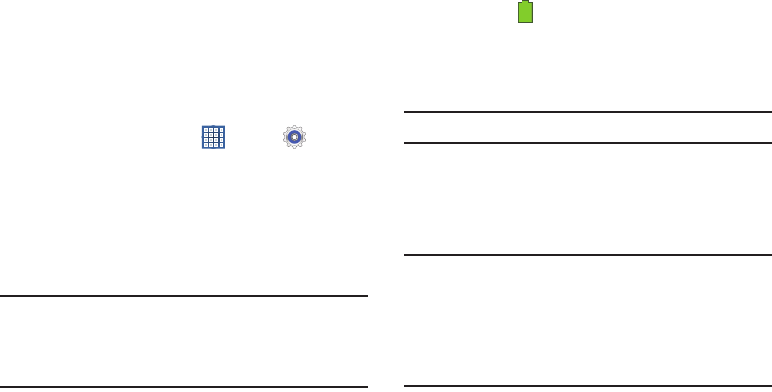
Getting Started 6
Text Conventions
This manual provides condensed information about how to
use your device. To make this possible, the following text
conventions are used to represent often-used steps:
Battery
Your device is powered by a rechargeable, standard Li-Ion
battery. A Wall/USB Charger (Charging Head and USB cable)
are included with the device for charging the battery.
Warning!
Use only approved charging devices. Approved
accessories are designed to maximize battery life.
Using other accessories may invalidate your
warranty and may cause damage.
Battery Indicator
The Battery icon in the Status Bar shows the battery
power level. When battery power is 15% or less, your device
prompts you to charge the battery. If you continue to operate
the device without charging, the device powers off. For
battery use information, see “About Device” on page 146.
Tip:
Touch the Time field to display battery charge status.
Charging the Battery
Your device comes with a Wall/USB Charger (Outlet
Connector, Charging Head, and USB cable) to charge your
device from any standard AC power outlet.
Note:
The battery comes partially charged. You must fully
charge the battery before using your device for the first
time.
After the first charge, you can use the device while
charging.
➔
Arrows are used to represent the sequence of selecting
successive options in longer, or repetitive, procedures. For
example:
From a Home screen, touch
Apps
➔
Settings
➔
Display
➔
Screen timeout
.
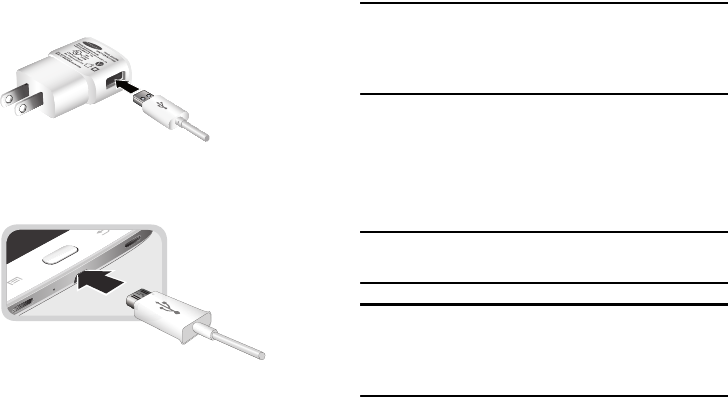
7
1. Insert the USB cable into the Charging Head.
2. Insert the USB cable into the device’s Charger/
Accessory Port.
Warning!
While the device is charging, if the touch screen
does not function due to an unstable power supply,
unplug the USB power adapter from the power outlet
or unplug the USB cable from the device.
3. Plug the Charging Head into a standard AC power
outlet.
4. When charging is complete, unplug the Charging Head
from the power outlet and remove the USB cable from
the device.
Note:
You cannot charge the battery using the USB cable and
your PC.
Note:
If the battery is completely discharged, you cannot turn
on the device, even with the USB power adapter
connected. Allow a depleted battery to charge for a few
minutes before you try to turn on the device.
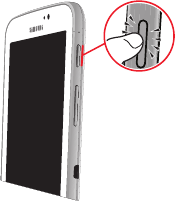
Getting Started 8
Turning Your Device On and Off
Turning Your Device On
Press and hold the
Power/Lock
Key
.
For more information, refer
to “Unlocking the Device”
on page 16.
Note
: Your device’s internal
antenna is located along
the top back of the device.
Do not block the antenna;
doing so may affect signal
quality and may cause the
device to operate at a
higher power level than is
necessary. For more
information, refer to “GPS
Applications” on page 94.
Turning Your Device Off
1. Press and hold the
Power/Lock
Key
.
2. At the
Device options
prompt, touch
Power off
.
3. At the
Power off
prompt, touch
OK
.
Setting Up Your Device
When you first turn on your device, you are asked to set up a
few things. To do that, the following screens display. Some
screens can be skipped (touch
Next
) or re-displayed (touch
Back
). Some screens display depending on the options you
choose.
Welcome!
1. Touch the
Select language
field, scroll through the list,
and touch the language you want your device to use,
such as, English (United States).
2. If required, touch
Accessibility
to change the
accessibility settings. For more information, refer to
“Accessibility” on page 143.
3. Touch
Next
.

9
Wi-Fi
Make sure the Wi-Fi
OFF / ON
icon is set to ON and
choose one of the following options:
Touch
Add Wi-Fi network
to enter a Network SSID that is
not listed.
Touch
Scan
to make sure you have an accurate list of
Wi-Fi networks.
Touch one of the Wi-Fi networks in the list, enter the
password, and touch
Connect
. Touch and connect to
another Wi-Fi network or touch
Next
to continue.
Touch
Next
to perform this task later. For more
information, refer to “Wi-Fi” on page 116.
Set Date and Time
1. Under
Set date
, set the date (month, day, year), if
necessary.
2. Under
Set time
, set the time (hour, minute, and AM or
PM), if necessary.
3. Under
Select time zone
, set the time zone field (
GMT
)
and select the correct time zone.
4. Touch
Next
.
End User License Agreement
1. Read the End user license agreement and touch the
I understand and agree to the terms and conditions
above
check box.
2. If you do not agree to provide Samsung the error log
data from any Software Update failure your device
experiences, touch the
No thanks
button.
3. Touch
Next
.
Samsung Account
Sign in to your Samsung account to use Samsung services.
1. Touch
variety of services
to learn more.
2. Touch
Create new account
to create a Samsung
account.
– or –
Touch
Sign in
if you already have a Samsung account.
Touch
Restore
and
Auto backup
, if desired. Touch
Next
.
– or –
Touch
Skip
to perform this task later. For more
information, refer to “Signing In to your Samsung
Account” on page 142.

Getting Started 10
Got Google?
Your new device uses your Google account to fully use its
Android features, including Gmail, Maps, Navigation,
Google Talk, and Google Play.
The Got Google? screen allows you to sign in, if you already
have a Google account.
Note:
If you skipped Wi-Fi setup, the Wi-Fi setup screen
displays and you must connect through a Wi-Fi network.
Touch
Yes
and then enter the email address and
password of your existing account.
Touch to continue.
– or –
Touch
No
to proceed to the next screen.
Make it Google
This screen displays if you did not sign in to your Google
account.
The Make it Google screen allows you to create a new
Google account.
Note:
If you skipped Wi-Fi setup, the Wi-Fi setup screen
displays and you must connect through a Wi-Fi network.
Touch
Get an account
or enter the email address and
password of your existing account.
– or –
Touch
Not now
to perform this task later. For more
information, refer to “Setting Up Your Gmail Account”
on page 47.

11
Entertainment
This screen displays if you signed in to your Google account.
Touch
Set up a credit card
, enter credit card information
for your Google Play account, and touch
Save
.
– or –
Touch
Not now
.
Backup and Restore
This screen also displays if you signed in to your Google
account.
1. Read the backup and restore information.
2. Enable either or both options.
3. Touch to continue.
The Restoring screen displays while your information is
being restored.
Google & Location
1. Read the information on the screen and enable either
or both of the Google location services.
2. Touch to continue.
This Tablet Belongs To ...
This screen displays if you did not sign in to your Google
account.
To personalize the tablet with your name:
1. Touch the First and Last fields and use the on-screen
keyboard to enter you first and last name.
2. Touch to continue.
Free Dropbox Account
To get a free 50 GB Dropbox account for two years:
1. Touch
Create account
, enter the required fields, and
touch
Register for Dropbox
.
– or –
Touch
Sign in
to sign in to Dropbox.
– or –
Touch
Skip
to skip this offer.

Getting Started 12
Setup Complete
Congratulations! Your device is set up and ready to use.
Touch
Finish
.
The main Home screen displays.
Creating a New Google Account
In order to utilize your device to the fullest extent, you will
need to create a Google Account when you first use your
device. With a Google Account, Google applications will
always be in sync between your tablet and computer.
If you need to create a Google account, follow these steps:
1. From a Home screen, touch
Apps
➔
Gmail
.
The
Add a Google Account
screen displays.
2. Touch
New
to create a new Google account.
For more information, refer to “Setting Up Your Gmail
Account” on page 47.
Retrieving Your Google Account
Password
A Google account password is required for Google
applications. If you misplace or forget your Google Account
password, follow these instructions to retrieve it:
1. From your computer, use an Internet browser to
navigate to
http://google.com/accounts
.
2. Once the URL loads, click on the
Can’t access your
account?
link and follow the on-screen instructions.
Using Google Maps
In order to use some applications related to Google Maps,
you must first connect Wi-Fi. For more information, refer to
“Wi-Fi” on page 116.
You must also enable location services to use Google Maps.
Some features require Standalone or Google location
services. For more information, refer to “Location Services”
on page 129.

13
Task Manager
Your device can run applications simultaneously and some
applications run in the background.
Use Task Manager to see which applications are running on
your device and to end running applications to extend battery
life. You can also uninstall applications from your device and
see how much memory is used by applications.
Task Manager Application
The Task Manager application provides information about
applications, including
Active applications
,
Downloaded
,
RAM manager
,
Storage
, and
Help
.
To access the Task Manager:
1. Add the Active apps manager widget to a Home screen
and then touch
Active applications
on the Active apps
manager widget. For more information, refer to
“Widgets” on page 29.
2. Touch
Active applications
to view applications running
on your device. Touch
End
to end an application or
End all
to end all running applications.
3. Touch
Downloaded
to view applications installed from
Google Play. Touch
Uninstall
to remove an application
from your device.
4. Touch
RAM manager
to display the amount of Random
Access Memory (RAM) currently in use. Touch
Clear
memory
to clear inactive and background processes.
5. Touch
Storage
to view internal (Device memory) and
external (SD card) storage memory statistics.
6. Touch
Help
to view useful tips for extending battery life.
For more information, refer to “Apps Screen” on page 32.
Memory Card
Your device supports removable microSD or microSDHC
memory cards with maximum capacities of 64 GB
(depending on the memory card manufacturer and type).
Memory cards are used to store music, photos, videos, and
other files.
Note:
You can only store music files that you own (from a CD
or purchased with the device) on a memory card.
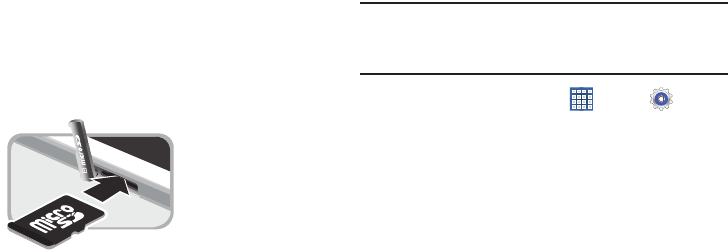
Getting Started 14
Installing a Memory Card
1. Open the Memory Card Slot cover and turn to expose
the slot.
2. With the gold contacts facing down, carefully slide the
memory card into the slot, pushing gently until it clicks
into place.
3. Replace the Memory Card Slot cover.
Removing a Memory Card
Important!
To prevent damage to information stored on the
memory card, unmount the card before removing it
from the device.
1. From a Home screen, touch
Apps
➔
Settings
➔
Storage
.
2. Under
SD card
, touch
Unmount SD card
and then
touch
OK
.
3. Open the Memory Card Slot cover and turn to expose
the slot.
4. Gently press down on the memory card, so that it pops
out from the slot, and carefully pull the card out.
5. Replace the Memory Card Slot cover.
For more information, refer to “Memory Card” on page 92.

15
Galaxy Tab Accessories
To find accessories for your Galaxy Tab:
1. Go to
http://www.samsung.com/us/mobile/galaxy-tab-
accessories
.
Galaxy Tab accessories display.
2. Use your model number to find compatible
accessories.
Securing Your Device
By default, the device locks automatically when the screen
times out or you can lock it manually. You can unlock the
device using one of the default Unlock screens or, for
increased security, use a personal screen unlock pattern.
For more information about creating and enabling a Screen
unlock pattern, see “Screen Lock” on page 130.
For other settings related to securing your device, see
“Location Services” on page 129.
Note:
Unless stated otherwise, instructions in this User Manual
start with the device unlocked, at the Home screen.
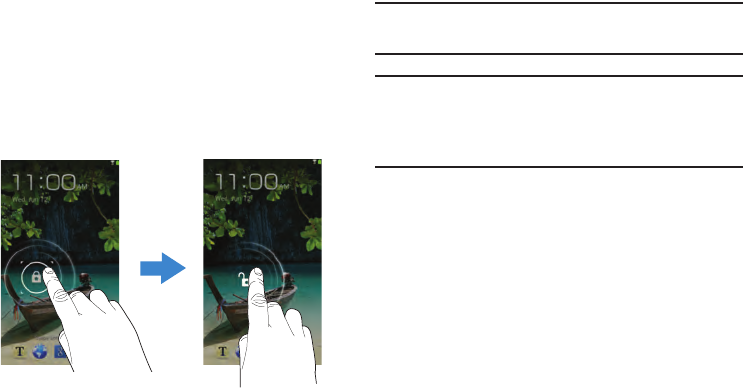
Getting Started 16
Locking the device manually
Press the
Power/Lock Key
.
Unlocking the Device
1. Press the
Power/Lock Key
.
The Lock screen displays.
2. Swipe across the screen as shown.
The last screen you accessed displays.
Tip:
Touch one of the app shortcut icons and then swipe to
launch that application.
Note:
You can customize the Lock screen and set the type of
Screen Unlock you want to use (Face unlock, Pattern,
PIN, or Password). For more information, refer to
“Screen Lock” on page 130.
Troubleshooting
If your device has fatal errors, hangs up, or freezes, you may
need to reset the device to regain functionality.
•
If your device is frozen and unresponsive, press and hold the
Power/Lock Key
for 8 to 10 seconds.

17
Section 2: Understanding Your Device
This section outlines key features of your device and
describes the screen and the icons that appear when the
device is in use. It also shows how to navigate through the
device.
Features
•
7.0-inch WSVGA (1024x600) TFT (PLS) LCD touch screen
•
Android Version 4.1.2
•
Wi-Fi, 1.2 GHz dual-core processor
•
Full HTML Web Browser
•
Bluetooth 3.0 Wireless technology. For more information, refer to
“Bluetooth”
on page 118.
•
Built-in Wi-Fi technology (802.11 a/b/g/n)
•
3 megapixel camera and camcorder, plus 1.3 megapixel
forward-facing camera for video chat
•
Full integration of Google applications (Gmail, YouTube,
Google Maps, and Voice Search)
•
Photo gallery that supports GIF, AGIF, JPEG, PNG, BMP, WBMP, and
WEBP formats
•
Messaging Features:
–
Gmail
–
Email (corporate and personal)
–
Google Talk
(Instant Messaging and Video Chat)
•
HD Video Player (1080p)
–
Codec: MPEG4, H.264, H.263, VC-1, DivX, VP8, WMV7/8,
Sorenson Spark, MP43
–
Format: AVI, MP4, 3GP, MKV, WMV, ASF, FLV
•
DivX Certified
®
to play DivX
®
video up
to HD 720p
, including
premium content
•
Music player that supports MP3, AAC/AAC+/EAAC+, WMA, Vorbis,
FLAC, AC-3, AMR-NB/WB, WAV
•
Support for microSD and microSDHC
memory cards
•
Preloaded applications such as AllShare Play, Google Play Books,
Google Play
Store, Music Hub, and Polaris Office. For more
information, refer to
“More Application Information”
on
page 33.
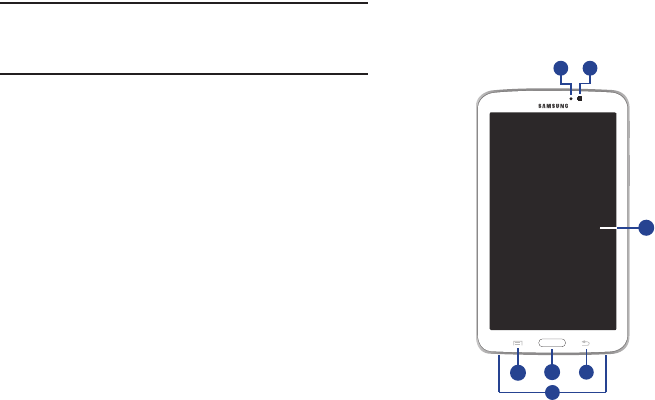
Understanding Your Device 18
Warning!
This device does not support some USB storage
media devices. For more information, refer to
“Galaxy Tab Accessories” on page 15.
Front View
The following items can be found on the front of your device
as illustrated.
1.
Light Sensor
: Used to control screen brightness
automatically when taking photos with the front-facing
Camera.
2.
Front-facing Camera Lens
: Used when taking photos or
recording videos.
3.
Display Screen
: The orientation of the display screen
rotates with the tablet as you turn it. You can turn this
feature on and off. For more information, refer to
“System” on page 144.
4.
Back
: Return to the previous screen or option.
5.
Home
: Display the central Home screen. Touch and
hold to display recent apps that have been accessed.
6.
Menu
: Display a list of options.
7.
External Speakers
: Used in music or video playback,
notification tones, and for other sounds.
1
7
4
1
2
3
5
6
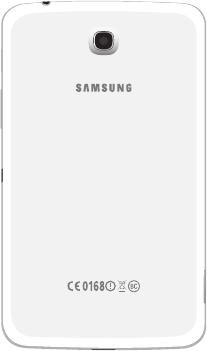
19
Back View
1.
3.5mm Headset Jack
: Plug in for headphones.
2.
Camera Lens
: Used when taking photos or recording
videos.
3.
Memory Card Slot
: Install a memory card for storage of
files.
4.
Charger/Accessory Port
: Plug in a USB cable for
charging or to sync music and files.
5.
Infrared Blaster
: Emits infrared signals used for
controlling external devices. For more information,
refer to “Smart Remote” on page 113.
6.
Volume Key
: From a Home screen, press to adjust
Master Volume. During music playback, press
to adjust
volume.
7.
Power/Lock Key
: Press and hold to turn the device on or
off. Press to lock the device or to wake the screen for
unlocking.
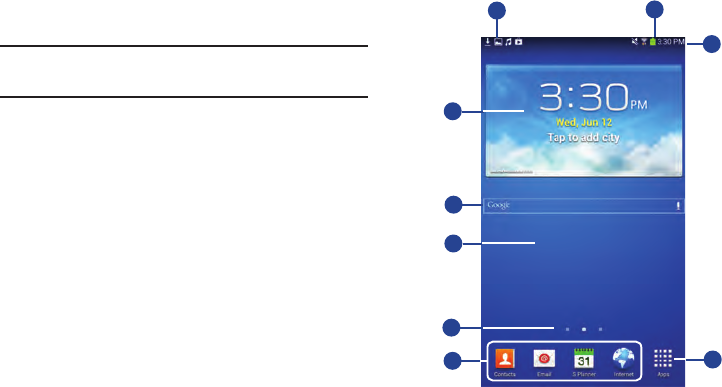
Understanding Your Device 20
Home Screen
The Home screen is the starting point for using your device.
Note:
Unless stated otherwise, instructions in this user manual
start with the device unlocked, at the Home screen.
1.
System Bar
: The area along the bottom of the Home
screen where you can find navigation buttons and
icons that show notifications, battery power, and
connection details.
2.
Status Icons
: Indicate the status of your tablet. Touch
the Time / Status Icons area to display the Status
Details panel. For more information, refer to “Status
Bar” on page 28.
3.
Time
: The current time. For more information, refer to
“Date and Time” on page 143.
4.
Apps
: Display the Apps screen.
5.
Primary Shortcuts
: Shortcuts to common features.
These shortcuts are found on all Home screens by
default. For more information, refer to “Primary
Shortcuts” on page 29.
6.
Current screen
: Indicates which Home screen is being
displayed. For more information, refer to “Extended
Home Screen” on page 21.
4
3
2
5
7
8
9
1
6

21
7.
Home screen
: The starting point for using your device.
Place shortcuts, widgets, and other items to customize
your device to your needs.
8.
Google Search
: Search the web by typing or speaking.
For more information, refer to “Google Search” on
page 54.
9.
Widgets
: Applications that run on the Home screen.
Some widgets are found on the Home screen by
default. For more information, refer to “Widgets” on
page 29.
Extended Home Screen
The Home screen consists of the Home panel plus additional
panels that extend beyond the display width to provide more
space for adding shortcuts and widgets. For more
information, refer to “Adding and Removing Home Screen
Panels” on page 22.
Slide your finger horizontally across the screen to scroll to
the left or right side panels. As you scroll, the indicator at the
top of the display shows your current position.
Note:
The center panel displays when you touch
Home
.
Customizing the Home Screens
To customize the Home screens to suit your preferences:
1. Navigate to one of the Home screen panels.
2. Touch and hold on the screen until the
Home screen
pop-up displays.
3. Touch
Set wallpaper
to change the Home screen
wallpaper. For more information, refer to “Wallpapers”
on page 32.
4. Under
Add to Home screen
touch:
• Apps and widgets
to add app or widget shortcuts on the
Home screen.
•Folder
to add a folder on a Home screen. For more
information, refer to
“Folders”
on page 31.
•Page
to add a Home screen.
Display Settings
You can customize display screen settings to your
preferences. For more information, refer to “Display” on
page 124.
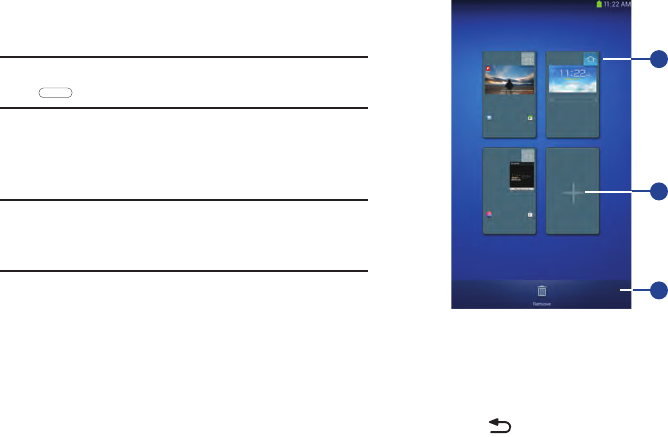
Understanding Your Device 22
Adding and Removing Home Screen Panels
Your device comes with seven Home screen panels. You can
customize the Home screen by removing or adding panels.
Note:
The panel in the center position displays when you touch
Home
.
From a Home screen, pinch the screen from the left
and right side to the center to display the editing
screen.
Tip: Tip:
Touch and hold on the screen until the
Home screen
pop-up displays. Under
Add to Home screen
, touch
Page
to
add a Home screen.
Use these controls to configure panels:
1.
Default Home Page
: Touch the Home icon on a panel to
set it as the default home screen.
2.
Add
: Touch to add a new panel, up to a total of seven.
This option is available when less than seven panels
have been added.
3.
Remove
: Touch and drag a panel to the Trash Can to
remove the panel from the Home screen.
To rearrange the order of panels:
Touch and drag a panel to a new location.
To return to the Home screen:
Touch
Back
.
3
2
1
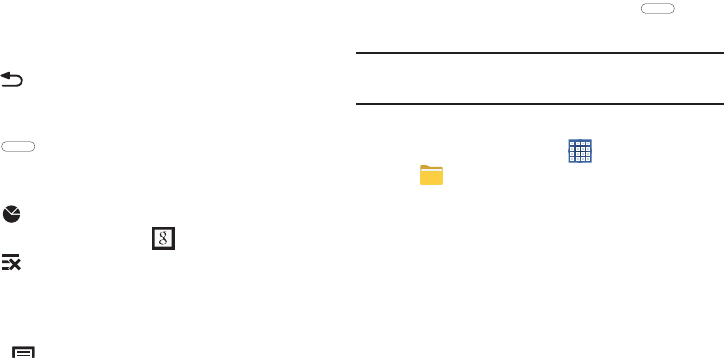
23
Navigating Your Device
Use command buttons and the touch screen to navigate.
Command Buttons
Back
Touch
Back
to return to the previous screen, option, or
step.
Home
Touch
Home
to display the center Home screen.
Touch and hold to open a list of thumbnail images of apps
you have worked with recently. Touch an App to open it.
Touch to display the Task Manager.
To launch Google Search, touch .
Touch to clear all thumbnail images.
Context-Sensitive Menus
Context-sensitive menus offer options for features or
screens. To access context-sensitive menus:
• Touch
Menu
to display a list of options.
• Touch an option in the list.
Screen Capture
Touch and hold the
Power/Lock Key
and
Home
to capture and save an image of the current screen.
Note:
A copy of the screenshot is automatically saved to the
clipboard.
To view the screen shots:
1. From a Home screen, touch
Apps
➔
My Files
.
2. Touch
storage
➔
sdcard0
➔
Pictures
➔
Screenshots
.
3. Touch a screen capture file to display it.
Application Bar
The Application Bar is the area along the top of various
application screens. It usually contains the Search and Menu
icons, as well as other icons that are used to display options
and settings.

Understanding Your Device 24
Screen Navigation
Touch
Touch items to select or launch them. For example:
•
Touch the on-screen keyboard to enter characters or text.
•
Touch a menu item to select it.
•
Touch an application’s icon to launch the application.
Touch and Hold
Activate on-screen items. For example:
•
Touch and hold a widget on the Home screen to move it.
•
Touch and hold on a field to display a pop-up menu of options.
Swipe, Flick, or Slide
Swipe, flick, or slide your finger vertically or horizontally
across the screen. For example:
•
Unlocking the screen.
•
Scrolling the Home screens or a menu.
Pinch
Use two fingers, such as your index finger
and thumb, to make an inward pinch
motion on the screen, as if you are picking
something up, or an outward motion by
sweeping your fingers out.
For example:
•
Pinch a photo in Gallery to zoom in.
•
Pinch a webpage to zoom in or out.
Notifications
When you receive a notification, the Notification icon displays
in the System Bar, to the left of the Time. Notifications
indicate the arrival of Gmail, Email, alarms, and more.
Status Details
To display the current date and time, battery status, and
Wi-Fi connectivity status, open Status Details.
1. Touch the top of the screen and swipe downward.
The Status Details screen displays. If you have any
current notifications, their summaries are listed below
the Notifications title.
2. Touch a notification summary to respond to it.
3. Touch
Home
,
Back
, or swipe up to close
the Status Details screen.
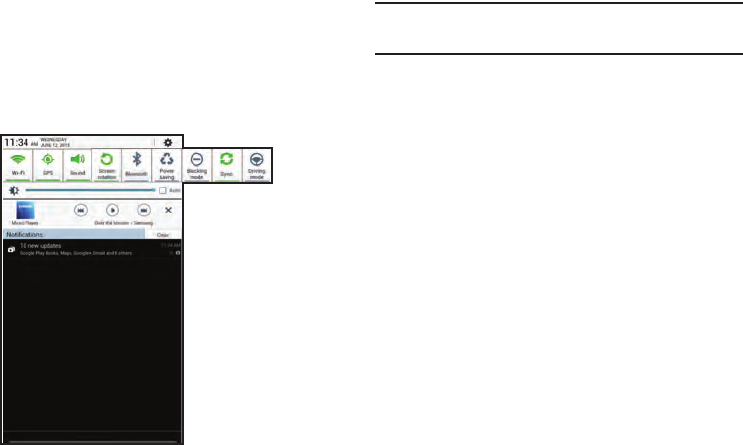
25
Quick Settings
To view and control the most common settings for your
tablet, as well as accessing the complete Settings
application, open the Quick Settings panel.
1. Touch the top of the screen and swipe downward.
The Quick Settings screen displays.
Note:
This screen displays both Status Details and Quick
Settings and is referred to by both names in this manual.
2. The Quick Settings are:
•Wi-Fi
: Touch to enable or disable Wi-Fi. For more information,
refer to
“Wi-Fi”
on page 84.
•GPS
: Touch to enable or disable Standalone GPS services. For
more information, refer to
“Location Services”
on
page 129.
•Sound / Mute
: Touch to enable or disable sound mode.
• Screen rotation
: When On the screen rotates automatically
from landscape to portrait and vice versa. When Off the screen
is fixed in the current mode, either portrait or landscape. For
more information, refer to
“System”
on page 144.
• Bluetooth
: Touch to enable or disable Bluetooth. For more
information, refer to
“Bluetooth”
on page 87.
• Power saving
: When enabled, your device automatically
analyzes the screen and adjusts the brightness to conserve
battery power. For more information, refer to
“System”
on
page 144.
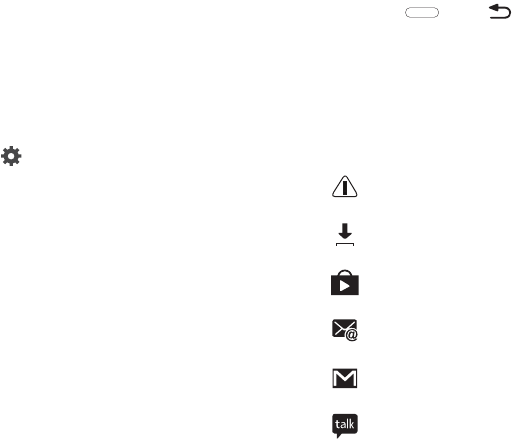
Understanding Your Device 26
Sweep the pop-up to the left to see additional settings.
• Blocking mode
: When enabled, notifications for selected
features will be disabled.
•Sync
: Synchronizes your device with the network.
Synchronizes contacts, email, time, and a variety of accounts.
• Driving mode
: New notifications are read aloud when enabled.
3. Touch
Settings
to open the Settings application.
For more information, refer to “Settings” on page 116.
4. Touch the
Brightness
slider and drag it to set the
brightness or touch
Auto
to allow the device to set
brightness automatically based on available light and
battery charge status. For more information, refer to
“Brightness” on page 124.
5.
Notifications
displays system notifications. Touch a
notification entry to display the details. Touch
Clear
to
remove Notification Icons from the System Bar.
For more information, refer to “Notifications” on
page 24.
6. Touch
Home
,
Back
, or swipe up to close
the Status Details screen.
Notifications display in the System Bar and, in some cases,
under the Notifications heading in the Quick Settings to alert
you to activity on the tablet such as new messages,
application downloads, software updates, and more. The
following table lists those icons.
System Alert
: Check under the Notifications heading
in the Quick Settings for alerts.
Download
: An application or file is being
downloaded or has been downloaded to the device.
Download Successful
: A recent application download
or update completed successfully.
New Email Message
: You have new email. Touch
Reply to view and answer the email.
New Gmail Message
: You have new Gmail. Touch the
icon for additional information.
Google Talk Invitation
: Someone has invited you to
chat using Google Talk.
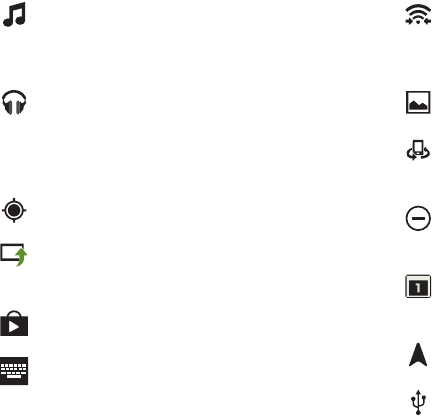
27
Music player
: Music is playing. Display the Status
Details to see the song title and music player
controls. For more information, refer to “Music
Player” on page 64.
Music App
: A song is playing in the Music app.
Touch the Music icon or touch the Status Details to
see the song title and music player controls. For
more information, refer to “Play Music App” on
page 61.
GPS Active
: Displays when GPS is active.
Software update
: There may be a software update
available for this device. For more information, refer
to “Software Update” on page 147.
Updates Available
: Updates to the applications you
have downloaded are available.
Choose input method
: When the keyboard is being
displayed, open the Quick Settings screen to display
a menu of quick keyboard settings. For more
information, refer to “Text Input Methods” on
page 34.
Wi-Fi Direct
: Displays when Wi-Fi Direct is active
and your tablet is connected to another device. For
more information, refer to “Wi-Fi Direct” on
page 86.
Screenshot Captured
: A screenshot has been
captured.
Nearby Devices
: The Nearby devices setting is
enabled. For more information, refer to “Nearby
Devices” on page 122.
Blocking Mode
: Notifications for selected features
are disabled. For more information, refer to
“Blocking Mode” on page 123.
Event
: This is a notification for one or more events.
For more information, refer to “Creating an Event or
Task” on page 109.
Navigation Active
: The Navigation App is active. For
more information, refer to “Navigation” on page 59.
USB Connected
: Device is connected to a computer
using a USB cable.
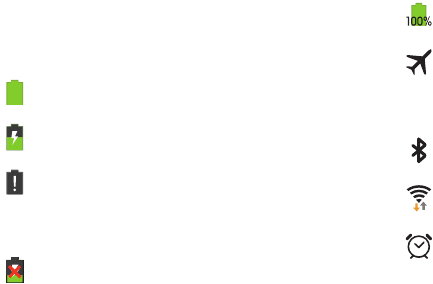
Understanding Your Device 28
Status Bar
The Status Bar is part of the System Bar and displays icons
to show network status, battery power, and other details.
Battery Level
: Shown fully charged.
Charging Indicator
: Battery is charging.
Device Power Critical
: Battery has only three percent
power remaining. At about 15 percent power
remaining, a pop-up is displayed to remind you to
charge immediately.
USB Connection Indicator
: The device is connected
to a computer using a USB cable, but it is not
charging. The battery is only charged while
connected to a computer, if the device is turned off.
When the device is off, press the Power/Lock key to
see the battery charging indicator.
Battery Fully Charged
: When the battery is fully
charged, this indicator is displayed.
Airplane Mode
: Indicates that the Airplane Mode is
active, which allows you to use many of your
device’s features, but it cannot access online
information or applications.
Bluetooth Active
: Bluetooth is turned on. For more
information, refer to “Bluetooth” on page 87.
Wi-Fi Active
: Wi-Fi is connected, active, and
communicating with a Wireless Access Point (WAP).
Alarm Set
: Displays when you set an alarm to ring at
a specified time. For more information, refer to
“Alarm” on page 95.

29
Primary Shortcuts
Primary Shortcuts display at the bottom of the Home
screens.
Tip:
The main Home screen is usually the center Home screen.
The default Primary Shortcuts are: Contacts, Email,
S Planner, Internet, and Apps.
Other App Shortcuts
There are also other application shortcuts on the Home
screens, such as Dropbox, Samsung Apps, and Play Store.
For more information, refer to “More Application Information”
on page 33.
Application shortcuts can be added to any Home screen. For
more information, refer to “App Shortcuts” on page 30.
Widgets
When you first turn on your tablet, there are various widgets
on the center Home screen. They can also appear on the
Home screens to the left and right of the center Home
screen.
Widgets are self-contained applications that you can place
on the Home screens to access your favorite features.
For more information, refer to “Applications” on page 94.
Adding Widgets to a Home screen
1. Navigate to the Home screen on which you want to
place the Widget and touch
Apps
.
2. Touch the
Widgets
tab.
Note:
Swipe across the screen horizontally to view all Widgets.
3. Touch and hold the widget’s icon until the Home screen
displays, then slide your finger where you want to
place the icon and release it.
Note:
There must be room on the screen where you want to
place the widget, otherwise the widget will not add to
the Home screen.

Understanding Your Device 30
Removing Widgets
Touch and hold the Widget until the
Remove
icon
displays, then drag the widget to the
Remove
icon.
Note:
This action does not actually delete the Widget, it just
removes it from the current Home screen.
App Shortcuts
Use App Shortcuts for quick access to applications or
features, such as Email or other applications.
1. Navigate to the Home screen on which you want to
place the App Shortcut.
2. Touch
Apps
.
– or –
Touch and hold on the screen until the
Home screen
options pop-up displays and then touch
Apps and
widgets
.
3. Touch the
Apps
tab.
4. Touch and hold the application icon until the Home
screen displays, then slide your finger where you want
to place the icon and release it.
For more information, refer to “Apps Screen” on
page 32.
5. Touch and hold the App Shortcut and then drag the
application icon to reposition it on the Home screen.
Removing App Shortcuts
Touch and hold the App Shortcut until
Remove
displays, then drag the App Shortcut to the
Remove
icon.

31
Folders
Place Folders on a Home screen to organize items together.
Adding Folders
To create a folder on a Home page:
1. Navigate to the desired Home screen.
2. Touch and hold on the screen until the
Home screen
pop-up displays and then touch
Folder
.
The Create folder pop-up displays.
3. Touch the
Unnamed folder
field, use the keyboard to
enter a name for the folder, and touch
OK
.
A new folder displays on the Home screen.
Managing Folders
To rename a folder:
Touch the folder, touch the current name, and use the
keyboard to enter a new name for the folder.
To add an App shortcut to a folder:
1. Add the App shortcut to the Home screen that the
folder is on.
2. Touch and hold the App shortcut, drag it to the folder,
and drop it.
To remove an App shortcut from a folder:
1. Touch the folder to view the contents.
2. Touch the App shortcut, drag it out of the folder, and
drop it on the Home screen.
Removing a Folder
Touch and hold the folder until the
Remove
icon
displays, then drag the folder to the
Remove
icon.
Note:
Any App shortcuts in the folder are also removed.
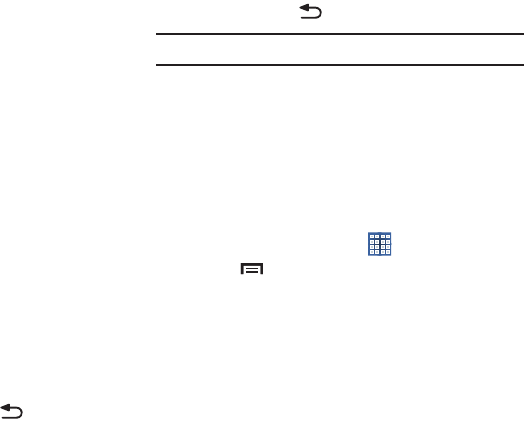
Understanding Your Device 32
Wallpapers
You can choose a picture to display on the Home Screen,
Lock screen, or on both the Home and Lock screens. Choose
from preloaded wallpaper images or select a photo you have
downloaded or taken with the Camera.
1. From a Home screen, touch and hold on the screen.
The
Home screen
options pop-up displays.
2. Touch
Set wallpaper
.
The Set wallpaper pop-up displays.
3. Touch
Home screen
,
Lock screen
, or
Home and lock
screens
.
The
Select wallpaper from
pop-up displays the
following options:
•Gallery
: Access the Gallery to select a photo. Touch a photo to
select it. Crop and resize the picture, if desired. Touch
Done
to
save the picture as wallpaper. Touch
Cancel
to cancel.
• Live wallpapers
: Choose from pre-loaded interactive animated
wallpapers. Touch a wallpaper to see an example. If available,
touch
Settings
to view options for the selection. Touch
Set
wallpaper
to save your choice. Touch
Back
to return to
the Live wallpapers menu.
• Wallpapers
: Choose from pre-loaded wallpaper images. Touch
an image to view it. Touch
Set wallpaper
to save it as
wallpaper. Touch
Back
to return to the Home screen.
Note:
Live wallpapers is not available for the Lock screen.
Apps Screen
The
Apps
screen displays all applications installed on your
wireless device. Applications that you download and install
from Google Play or from the web are also added to a Home
screen.
The Apps icons are arranged in a customizable grid. To
arrange the Apps icons in alphabetical order:
1. From a Home screen, touch
Apps
.
2. Touch
Menu
➔
View type
.
3. Touch
Alphabetical grid
.
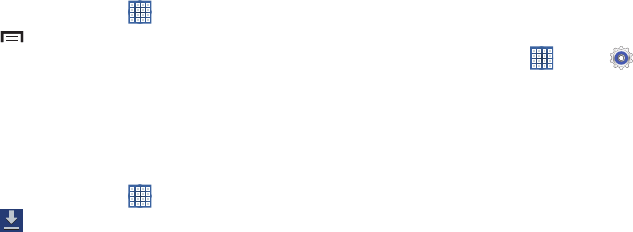
33
To manually change the order of the icons on the Apps
screen:
1. From a Home screen, touch
Apps
.
2. Touch
Menu
➔
Edit
.
3. Touch and hold an icon and drag it to a new position.
4. Touch
Save
to save the changes.
You can place shortcuts to applications on the Home screen
for quick access to the application. For more information,
refer to “App Shortcuts” on page 30.
To view your downloaded applications:
1. From a Home screen, touch
Apps
.
2. Touch
Downloaded applications
to view
downloaded apps.
3. Touch an icon on the
Downloaded applications
screen
to launch the application.
– or –
Add an App Shortcut to a Home screen by dragging the
App icon onto the Home Screen. For more information,
refer to “App Shortcuts” on page 30.
Application Information
To view information about an App, such as the amount of
storage it uses, force the App to stop, uninstall updates, and
clear data:
1. From a Home screen, touch
Apps
➔
Settings
➔
Application manager
.
2. Touch the
All
tab, scroll through the apps list, and
touch the app to open a screen with details about the
App.
More Application Information
For more information, refer to “Applications” on page 94.
In that section, each application that is available on the
Applications screen is listed and described. If the application
is also described in another section of this user manual, then
a cross reference to that particular section is provided.
Various widgets are also described.

Understanding Your Device 34
Entering Text
This section describes how to select the desired text input
method when entering characters into your tablet. This
section also describes the predictive text entry system that
reduces the amount of key strokes associated with entering
text.
Your tablet comes equipped with an orientation detector that
can tell if the tablet is being held in an upright (Portrait) or
sideways (Landscape) orientation. This is useful when
entering text.
Text Input Methods
Your device offers two text input methods.
•
Google voice typing and
•
Samsung keyboard.
You can set a default text entry method in Settings. For more
information, refer to “Keyboards and Input Methods” on
page 136.
To choose a text input method while entering text:
1. Touch the top of the screen and swipe downward.
The Quick Settings screen displays.
Touch
Choose input method
.
The Choose input method pop-up displays.
2. Touch an input method to activate it.
For more information, refer to “Keyboards and Input
Methods” on page 136.
Using the Samsung Keyboard
The Samsung keyboard is a custom virtual QWERTY
keyboard, featuring optional predictive text or continuous
input. Input characters by touching the on-screen keys with
your finger or use speech recognition.
You can enable predictive text, to have the Samsung
keyboard match your key touches to common words and
displays them. The Personalization option learns from GMail,
Facebook, and Twitter. Log into these applications to enable
the Samsung keyboard to learn from your text input.
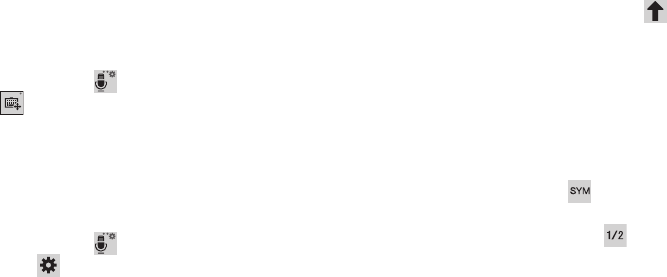
35
Keyboard Types
In addition to the default QWERTY keyboard, there is also a
Floating keyboard.
To change the keyboard type:
1. Access the QWERTY keyboard.
2. Touch and hold on the keyboard and then select
from the pop-up menu
.
3. Touch the tab at the top of the Floating keyboard to
move it.
Configuring the Samsung Keyboard
You can configure the Samsung keyboard to your
preferences. While entering text:
Touch and hold
Options
on the keyboard and then
touch
Settings
.
The Samsung keyboard settings screen displays.
For more information, refer to “Configuring the Samsung
Keyboard” on page 137.
Entering Upper and Lower Case Letters
The default case is lower case (abc). Enter upper and lower
case alphabet letters by touching the Shift key to toggle
the case, before touching the letter key(s).
•
Touch once to switch from abc to Abc mode.
•
Touch twice to switch to ABC mode. When ABC mode is enabled,
the Shift key background turns blue.
Entering Symbols and Numbers
The number keys are displayed at the top of the keyboard
and are always available.
To enter common symbols, touch to switch to symbol
mode, then touch the corresponding key.
There are two pages of symbols. Touch to switch to the
next page.
Touch and hold a vowel key (A, E, I, O, U, or Y) or the C, N, or
S key to open a small window where you can chose an
accented vowel or other alternate letter. Slide to the letter
until it is highlighted, and release.
Touch and hold the Period key ( . ) to open a small window
with a set of common symbols.
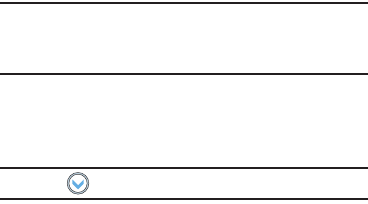
Understanding Your Device 36
Using Predictive Text
By using Predictive text, you can have next-letter prediction
and regional error correction, which compensates for
touching the wrong keys on the QWERTY keyboard.
Note:
Enable Predictive text in Samsung keyboard settings.
For more information, refer to “Configuring the Samsung
Keyboard” on page 137.
While entering characters, potential word matches display in
the Predictive text area above the keyboard.
Touch a word to insert it into your text.
Tip:
Touch to display more words.
Using Google Voice Typing from the Samsung
Keyboard
When you enable the Google voice typing setting, you can
use your voice to enter text instead of the keyboard.
For more information about enabling Voice input, see “Using
Google Voice Typing” on page 38
Editing Text
You can edit the text you enter in text fields by cutting,
copying, or pasting text. These operations can be performed
within and across apps. However, some apps do not support
editing some or all of the text displayed while others may
offer their own way to select text.

37
Editing Existing Text
To edit text that you have entered:
1. Touch the text at the point you want to edit.
The
Cursor
displays at the point you touched.
2. Touch and drag the
Cursor
to a better position, if
necessary.
3. Enter additional text or delete text by repeatedly
touching the
Delete
key.
Copying, Deleting, or Replacing Text
To select and copy, delete, or replace text:
1. Touch and hold the text or word you want to select.
The selected text is highlighted with a tab at
each end of the selection.
2. Touch and drag either tab to select more or less text.
Tip:
Touch
Select all
in the Application bar to select all text in
the field. Touch on another area of the screen or touch
Done
to deselect the text.
3. Depending on the action you want to take for the
selected text, in the Application bar touch:
•Select all
to highlight all text in the field.
•Cut
to remove the selected text.
•Copy
to save the selected text to the clipboard.
•
Touch
More options
to display:
–
Paste
to paste previously copied text.
–
Clipboard
to display the text saved to the clipboard.
– or –
Enter text by typing or speaking to replace the
selection with what you type.
– or –
Touch the
Delete
key to delete the selected text.

Understanding Your Device 38
Pasting Text
To paste previously copied text:
1. Touch the text at the point you want to paste the copied
text.
The
Cursor
displays at the point you touched.
2. Touch the Cursor.
A pop-up displays.
3. Touch
Paste
in the pop-up.
To paste text directly from the clipboard:
1. Touch the
Clipboard
key to display the text saved
to the clipboard.
2. Touch a text block to paste that text where the
Cursor
is
positioned.
Closing the Keyboard
To close the keyboard:
Touch
Close Keyboard
.
Using Google Voice Typing
You can use your voice to enter text using the Google voice
typing feature.
While entering text:
1. Touch on the keyboard.
For more information, refer to “Keyboards and Input
Methods” on page 136.
2. At the
Tap to speak
prompt, touch and speak
clearly and distinctly into the microphone.
The software converts your voice to text, which is
displayed in the message.
3. Keep speaking to add more text.
4. Touch to display the Samsung keyboard.

39
Section 3: Contacts and Accounts
This section explains how to manage contacts and accounts.
Accounts
Your device can synchronize with a variety of accounts. With
synchronization, information on your device is updated with
any information that changes in your accounts.
•
Samsung account
: Add your Samsung account. For more
information, refer to
“Signing In to your Samsung Account”
on page 142.
•
ChatON
: Add your ChatON account. For more information, refer to
“ChatON”
on page 53.
•
Dropbox
: Add your Dropbox account. For more information, refer
to
“Dropbox”
on page 98.
•
Email
: Add an Email account to sync Contacts. For more
information, refer to
“Email”
on page 48.
•
Facebook
: Add your Facebook account to sync Contacts.
•
Google
: Add your Google account to sync your Contacts, Calendar,
and Gmail. For more information, refer to
“Gmail”
on page 47.
•
LDAP
: Add an LDAP account to find entries in an LDAP directory
server.
•
Microsoft Exchange ActiveSync
: Add your Exchange account to
sync Contacts, Calendar, and Email.
•
Server
: Add a server to sync and access your data.
Setting Up Your Accounts
Set up and manage your synchronized accounts with the
Accounts
setting.
1. From a Home screen, touch
Apps
➔
Settings
➔
Add account
.
2. Touch the account type.
3. Follow the prompts to enter your account credentials to
complete the set-up process.
Your tablet communicates with the appropriate account
servers to set up your account. When complete, your
account displays in the
Accounts
area of the Settings
screen.
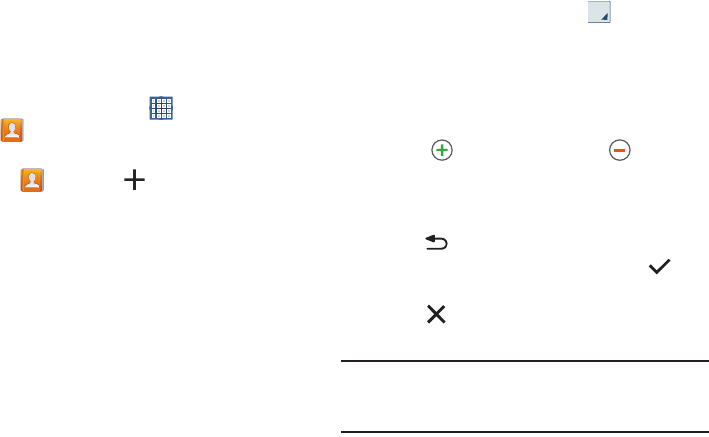
Contacts and Accounts 40
Contacts
Store contact information for your friends, family, and
colleagues to quickly access information or to send a
message.
To access Contacts:
From a Home screen, touch
Apps
➔
Contacts
.
Creating Contacts
1. Touch
Contacts
➔
Create
.
The Save contact to pop-up displays.
2. Touch
Device
or an account.
– or –
Touch Add new account to add a different account. For
more information, refer to “Setting Up Your Accounts”
on page 39.
3. Touch the
Contact photo to set up a photo to identify
the contact.
4. Touch contact fields to display the keyboard and enter
information:
•
Some fields have preset values. Touch the field and touch the
desired value. For example, touch the Label tab and
touch a label for the field.
•
Other fields have to be input. Touch the field and use the
on-screen keyboard to input information.
•
Touching the check box next to some fields may make
additional fields available.
•
Touch to add additional fields.Touch to remove an
unused field. Also, touch
Add another field
to add other fields.
•
Touch the screen and swipe up or down to display additional
fields or touch
Next
on the keyboard to move to the next field.
5. Touch
Back
to remove the keyboard.
6. When you finish entering information, touch
Save
.
– or –
Touch
Cancel
➔
OK
to cancel and discard
changes.
Tip:
Display a contact’s record and touch the
Email
field to
send an email, the
Address
field to display the address on
a map, or the
Website
field to link to the website.

41
Updating Contacts
To update an existing contact:
1. Touch
Contacts
.
2. Touch a contact in the Contacts list to view its
information.
3. Touch
Edit
.
4. Continue entering contact information. For more
information, refer to “Creating Contacts” on page 40.
Deleting Contacts
To delete a contact:
1. Touch
Contacts
.
2. Touch a contact in the
Contacts
list to view its
information.
3. Touch
Delete
.
4. At the prompt, touch
OK
.
Managing Photo IDs
To remove or update a contact’s Photo ID:
1. Touch
Contacts
.
2. Touch a contact in the
Contacts
list to view its
information.
3. Touch
Edit
.
4. Touch the Contact photo, then touch
Remove
,
Image
,
Take picture
, or
Pictures by people
.
Contacts Display Options
There are various ways to display your Contacts and general
Contacts settings.
1. Touch
Contacts
.
2. Touch
Groups
,
Favorites
, or
Contacts
, above the
Contacts List, to view contacts various ways:
•Groups
: Displays the possible Groups, such as Not assigned,
Co-workers, Family, Friends, and so on. The number of
contacts in the group is displayed next to the group name.
Touch a group name to show only contacts in that group. For
more information, refer to
“Creating a New Group”
on
page 44.

Contacts and Accounts 42
•Favorites
: Show only your favorite, or starred, contacts. For
more information, refer to
“Favorites”
on page 46.
•Contacts
: Show all your contacts. Touch the
Search
field and
enter a keyword to list contacts that contain that keyword.
3. From the
Groups
,
Favorites
, or
Contacts
list, touch
Menu
to display the options for each grouping.
4. From the
Contacts
list, touch
Menu
➔
Settings
to
display and manage Contacts settings.
Linked Contacts
Your device can synchronize with multiple accounts,
including Google, Corporate Exchange, and other email
providers. When you synchronize contacts from these
accounts with your device, you may have multiple contacts
for one person.
Linking, or joining, imported contact records allows you to
see all the contact’s numbers and addresses together in one
contact entry. Linking also helps you keep your contacts
updated, because any changes that your contacts make to
their information in the respective accounts is automatically
updated the next time you synchronize with the account.
Joining Contacts
1. Touch
Contacts
.
2. Touch a contact in the
Contacts
list to view its
information.
3. Touch
Menu
➔
Join contact.
4. Touch the contact you want to Join.
The joined contact’s information is displayed with the
original contact’s information.
5. Repeat Steps 3 and 4 to join other contacts.
Separating Contacts
1. Touch
Contacts
.
2. Touch a contact in the
Contacts
list to view its
information.
3. Touch
Menu
➔
Separate contact.
A list of Joined contacts displays.
4. Touch ➔
OK
to separate a joined contact.
The contact is removed from the list.
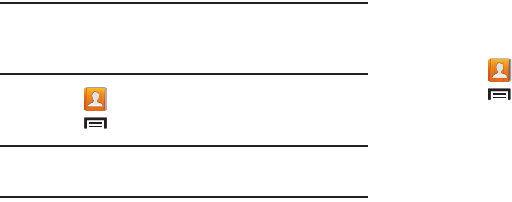
43
Sharing Contact Information
You can send a contact’s information by way of Bluetooth to
other Bluetooth devices or in an Email or Gmail as an
attachment.
Note:
Not all Bluetooth devices accept contacts and not all
devices support transfers of multiple contacts. Check
the target device’s documentation.
1. Touch
Contacts
.
2. Touch
Menu
➔
Share namecard via
.
Tip:
Set up a contact record for yourself to share your
information with others.
3. At the prompt, choose a sending method such as
Bluetooth.
4. Follow the prompts to send the contact information.
Importing and Exporting Contacts
To back up and restore your contacts information, you can
export your contacts list to a storage device, such as a PC, or
import your contacts list (previously exported) from a storage
device.
1. Use the USB cable to connect your device to the
storage device.
2. Touch
Contacts
.
3. Touch
Menu
➔
Import/Export
.
The Import/Export contacts pop-up displays.
4. Touch an option and then follow the prompts to
complete the operation.
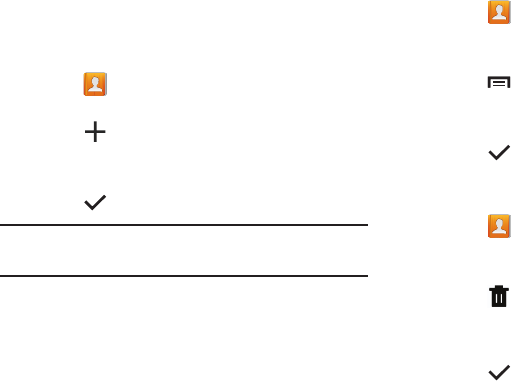
Contacts and Accounts 44
Groups
Assign contacts to Groups to make searching for contacts
faster or to quickly send messages to group members.
Creating a New Group
Create a new group when you add or edit a contact.
1. Touch
Contacts
.
2. Touch
Groups
above the Contacts List.
3. Touch
Create
.
4. Touch the
Group name
field and use the keyboard to
enter a new Group name.
5. Touch
Save
to save the new group name.
Tip:
Contacts can belong to more than one group. Just touch
the contact’s
Groups
field and touch each group.
Once you create a new group, the Contacts List can be set to
display only the contacts in that group. For more information,
refer to “Contacts Display Options” on page 41.
Renaming a Group
To rename a group that you created:
1. Touch
Contacts
.
2. Touch
Groups
and then touch the group you want to
rename.
3. Touch
Menu
➔
Edit
.
4. Touch the
Group name
field and use the keyboard to
enter a new Group name.
5. Touch
Save
to save the new group name.
Deleting Groups
To delete a group that you created:
1. Touch
Contacts
.
2. Touch
Groups
and then touch any group you want to
delete.
3. Touch
Delete groups
.
The groups that can be deleted display.
4. Touch
Select all
or the name of each group to delete.
5. Touch Delete to delete the groups. Choose from
Group only or Group and group members.

45
Adding Group Members
To add a contact to a group, just Edit a contact’s Group field.
For more information, refer to “Updating Contacts” on
page 41.
To add multiple contacts to a group:
1. Touch
Contacts
.
2. Touch
Groups
and then touch the group to which you
want to add members.
3. Touch
Menu
➔
Add member
.
The contacts that can be added display.
4. Touch
Select all
or the name of each contact to add.
5. Touch Done to add the contacts to the group.
Removing Group Members
To remove contacts from a group:
1. Touch
Contacts
.
2. Touch
Groups
and then touch the group from which you
want to remove members.
3. Touch
Menu
➔
Remove member
.
4. Touch
Select all
or the name of each contact to remove.
5. Touch Done to remove the contacts.
Contacts are removed from the group and the group
name is removed from each contact’s
Group
field.
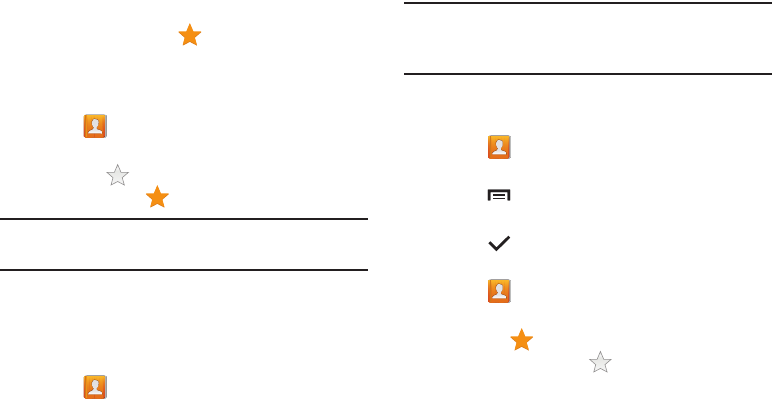
Contacts and Accounts 46
Favorites
Mark contact records with a gold star to identify them
as favorites.
Adding Favorites
To add a contact to the Favorites list:
1. Touch
Contacts
.
2. Touch a contact to display it.
3. Touch the
Star
next to the contact name so
that it turns gold .
Tip:
You do not have to edit the contact to change the Starred
status.
Accessing Favorites
You can view your favorites two ways for fast viewing or
messaging.
To view your favorites list:
1. Touch
Contacts
.
2. Touch
Favorites
above the Contacts List.
Only your starred contacts display.
Note:
Touch
Groups
above the Contacts List and then touch
Starred in Android
to list the Favorites that are being
saved on your Google account.
Removing Favorites
To remove one or more contacts from your favorites list:
1. Touch
Contacts
.
2. Touch
Favorites
above the Contacts List.
3. Touch
Menu
➔
Remove from favorites
.
4. Touch
Select all
or the name of each contact to remove.
5. Touch Done to remove the contacts.
To remove one contact from your favorites list:
1. Touch
Contacts
.
2. Touch a contact to display it.
3. Touch the
Star
next to the contact’s name so
that it is no longer gold .
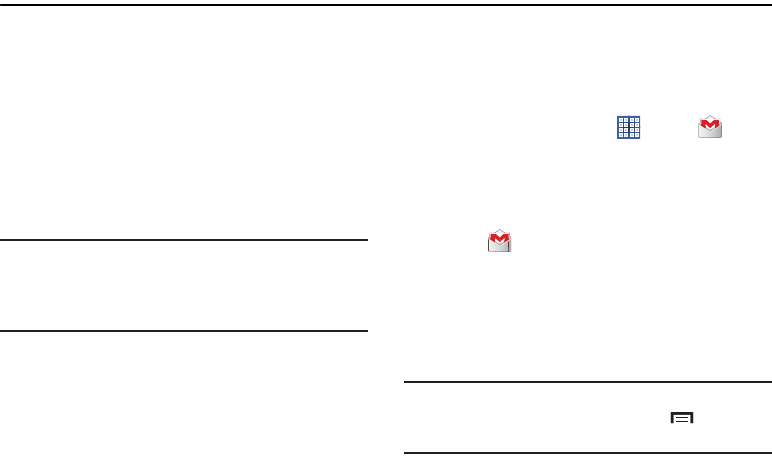
47
Section 4: Messaging
This section describes how to send and receive messages
and other features associated with messaging.
Types of Messages
Your device supports these types of messages:
•
Email and Gmail Messages
•
Google Talk
•
Google+
•
Google Messenger
•
ChatON
Note:
Your Wi-Fi-only device does NOT support voice calling
and messaging services. Please disregard any “dial”
and “message” related menus because some Gmail
options are identically set in all Android devices.
Gmail
Send and receive email with Gmail, Google’s web-based
email.
To access Gmail:
From a Home screen, touch
Apps
➔
Gmail
.
Setting Up Your Gmail Account
If you did not set up a Google account during the initial
configuration, the first time you launch Gmail, your device
prompts you to set up your Google account.
1. Touch
Gmail
.
The Add a Google Account screen displays.
2. Follow the prompts to sign in or create a new account.
The device communicates with the Google server to set
up your account and synchronize your email. When
complete, your Gmail displays in the Inbox.
Note:
You can use more than one Google account on your
device. To add another account, touch
Menu
➔
Settings
➔
ADD ACCOUNT
.
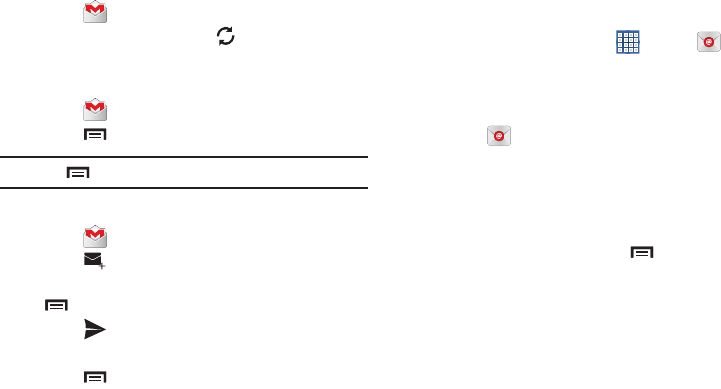
Messaging 48
Refreshing Your Gmail Account
Refresh your account to update your device from the Gmail
servers.
1. Touch
Gmail
.
2. In the Application Bar, touch
Refresh
.
Gmail Settings
Use the Gmail Settings to configure your Gmail preferences.
1. Touch
Gmail
.
2. Touch
Menu
➔
Settings
for settings.
Tip:
Touch
Menu
➔
Help
for more information.
Composing and Sending Gmail
1. Touch
Gmail
.
2. Touch
Compose
, then touch fields to compose
the message. While composing a message, touch
Menu
for options.
3. Touch
SEND
to send this message.
– or –
Touch
Menu
➔
Save draft
to save a draft of this
message.
Email
Use Email to view and manage all your email accounts in one
application.
To access Email:
From a Home screen, touch
Apps
➔
Email
.
Configuring Email Accounts
You can configure Email for most accounts in just a few
steps.
1. Touch
Email
.
2. The first time you set up an email account, at the Set
up email screen, enter an
Email address
and
Password
,
then touch
Next
.
– or –
For additional accounts, touch
Menu
➔
Settings
➔
Add account
.
3. Follow the on-screen instructions to set up your email
account.
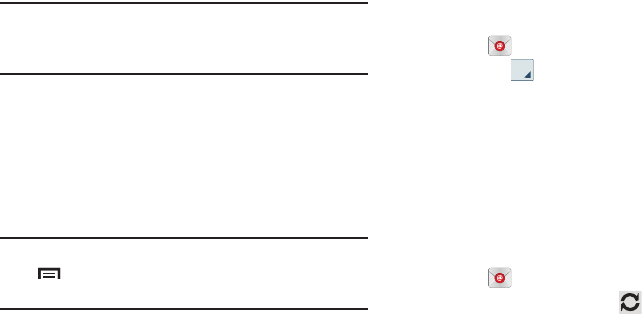
49
4. Touch
Next
to go to the next screen or touch
Previous
to
go to the Apps screen.
Note:
For Exchange ActiveSync accounts, the Activate device
administrator? screen may appear. Read the information
and touch
Activate
to continue.
5. Enter an account name and Your name, if required.
6. Touch
Done
.
The device communicates with the appropriate server
to set up your account and synchronize your email.
When complete, your email appears in the Inbox for the
account.
Note:
To configure email account settings at any time, use
Menu
➔
Settings
. Touch the account to display
Account settings.
Managing Your Email Accounts
You can view email you receive for all accounts in the
Combined view
screen or you can view email accounts
individually.
1. Touch
Email
.
2. Touch the
drop-down menu at the top left of the
screen to select:
• Combined view
: View all email in a combined inbox.
• Priority sender inbox
: Use this setting to assign an email
account for all outgoing emails.
•
<
Account Name
>: View email for the account.
Refreshing Your Email Account
Refresh your account to update your device from the Email
servers.
1. Touch
Email
.
2. In the Application Bar, touch
Refresh
.
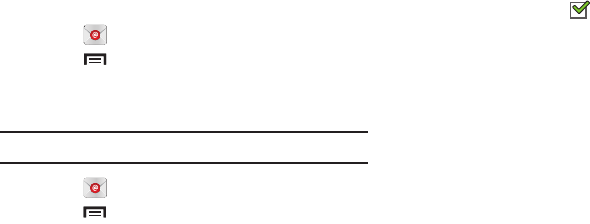
Messaging 50
Deleting Email Accounts
To delete an Email account:
1. Touch
Email
.
2. Touch
Menu
➔
Settings
➔
Delete account
.
Email Settings
Use the Email Settings to configure your Email preferences.
Note:
Available settings depend on the email provider.
1. Touch
Email
.
2. Touch
Menu
➔
Settings
, then touch
General
preferences
. The following options display:
• Auto-advance
: Set the screen to show after deleting a
message. Choices are: Next message, Previous message, or
Message list.
• Message preview line
: Choose a message preview line
amount. Options are: None or 1, 2, or 3 lines.
• Email title
: Set whether the Subject or Sender of the email is
shown as the title.
• Confirm deletions
: Touch the box to enable or disable this
option. A check mark indicates that deletions must be
confirmed.
•Quick responses
: Edit text that you frequently use in emails.
•Priority senders
: Enter email addresses that you want treated
as a priority.
• Email notifications
: When enabled, the New Email icon
appears in the Status Bar when a new email arrives.
• Select ringtone
: Choose a ringtone for email notifications for
this account.
3. Touch an account to configure specific settings.
Available options depend on the account.
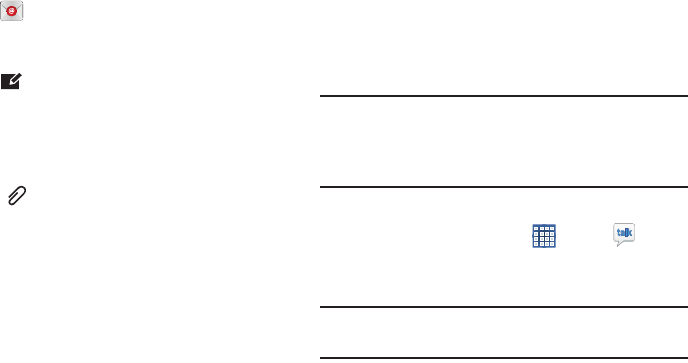
51
Composing and Sending Email
1. Touch
Email
.
2. If you have multiple accounts set up, choose an
account from the menu at the top of the screen.
3. Touch
Compose
, then touch fields to enter
recipients and the email text.
4. While composing a message:
•
Touch displayed buttons to set Priority, Tracking options,
Security options, and so on.
•
Touch
Attach
to add a file to the message.
Available options depend on the type of email account.
5. Touch the body of the email to enter the text of your
email. Touch the text option buttons to edit and format
your message text.
6. Touch
Send
to send the message.
– or –
Touch
Save
to save the email to the Drafts folder.
Google Talk
Talk is Google’s instant messaging and audio and video chat
service. You can use it to communicate, in real time, with
other people who also use Google Talk on another Android
tablet or phone or on a computer.
Tip:
Talk requires that you have a Google account. To set up
your Google account on your device use
Accounts
settings. For more information, refer to “Accounts” on
page 140.
Open Talk and Sign In
1. From a Home screen, touch
Apps
➔
Talk
.
If you are not signed in to a Google account, the Add a
Google Account screen displays.
Note:
If you have already set up your Google account, you are
automatically logged in. Just touch the account.
Once sign in is complete, the Talk main screen
displays.
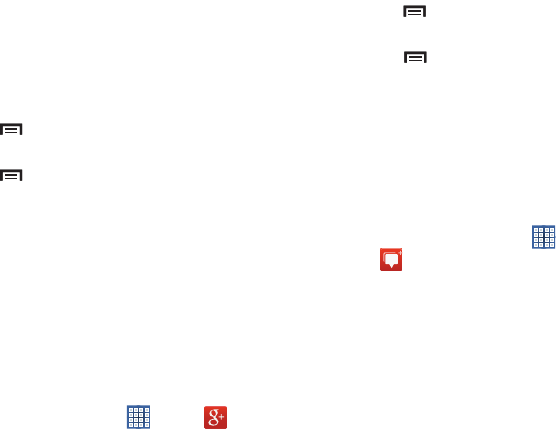
Messaging 52
2. Follow the on-screen instructions to invite friends to
chat.
You can invite anyone with a Google Account to
become your friend in Google Talk, so you can chat
with each other and view each other’s online status.
3. Touch
Menu
➔
Settings
to configure your Talk
preferences.
4. Touch
Menu
➔
Help
to display additional help
information.
Google+
Google+ makes messaging and sharing with your friends a
lot easier. You can set up Circles of friends, visit the Stream
to get updates from your Circles, use Messenger for fast
messaging with everyone in your Circles, or use Instant
Upload to automatically upload videos and photos to your
own private album on Google+.
1. Sign in to your Google account. For more information,
refer to “Setting Up Your Gmail Account” on page 47.
2. From a Home screen, touch
Apps
➔
Google+
.
3. Follow the on-screen instructions to use Google+.
4. Touch
Menu
➔
Settings
to configure your Google+
preferences.
5. Touch
Menu
➔
Help
to display additional help
information.
Messenger
With Google Messenger, you can bring groups of friends
together into a simple group conversation, putting everyone
on the same page. When you get a new conversation in
Messenger, Google+ sends an update to your device.
To get started:
1. From a Home screen, touch
Apps
➔
Messenger
.
The Messenger screen displays.
2. Touch
Learn more
in the center of the screen and
then touch a topic to learn more about using
Google Messenger.

53
ChatON
A smart-messaging app that gives you a host of innovative
ways to stay connected with all your friends and family,
regardless of their device or platform. Use ChatON to send
and receive instant messages from any device that has a
mobile phone number.
1. From a Home screen, touch
Apps
➔
ChatON
.
If you are launching this application for the first time,
follow the on-screen instructions to complete the
account setup.
2. Enter and send your message.
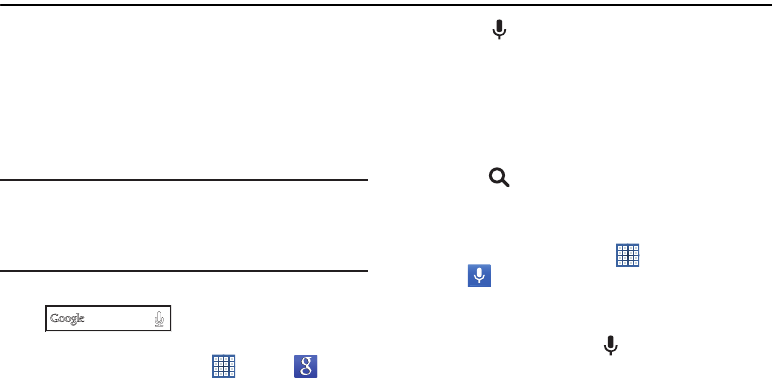
Internet and Social Networking 54
Section 5: Internet and Social Networking
This section describes the various Internet and social
networking applications available on your device such as
Google and Voice Search, Google+, Internet, Local, Maps,
Navigation, Google Play Books, Play Magazines, and
YouTube.
Google Search
Search the internet using the Google search engine.
Tip:
The Google Search widget displays by default on the main
Home screen. For information about displaying widgets on
the Home screen, see “Adding Widgets to a Home screen”
on page 29.
1. From the main Home screen, touch
.
– or –
From a Home screen, touch
Apps
➔
Google
.
2. Use the keyboard to enter search criteria to display
matching searches.
– or –
Touch and speak the search criteria slowly and
clearly. Google searches for the information and
displays results.
Suggestions display below the text entry area.
3. Touch a suggestion to search for that term.
– or –
Touch on the keyboard to start the search.
A browser window displays the search results.
To use Voice Search directly:
1. From a Home screen, touch
Apps
➔
Voice Search
.
2. Speak the search criteria slowly and clearly. Google
searches for the information and displays results or
displays
Retry
. Touch the to retry speaking the
search words.
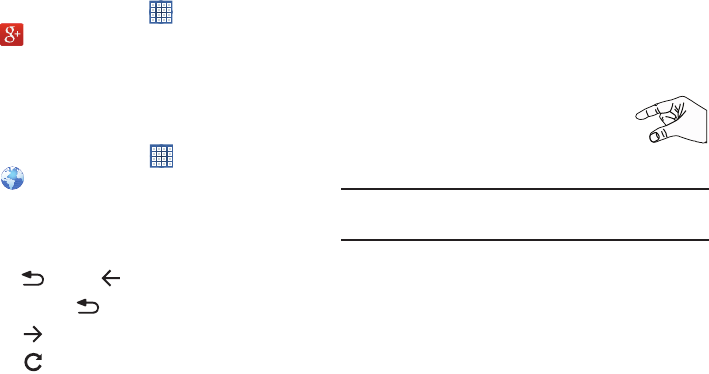
55
Google+
Share updates and see what is going on around you with
Google+ for mobile.
To get started:
1. From a Home screen, touch
Apps
➔
Google+
.
2. For more information, refer to “Google+” on page 52.
Internet
Your device is equipped with a full HTML Browser that allows
you to access the Internet.
From a Home screen, touch
Apps
➔
Internet
.
Navigating the Internet
The following options are available for Internet navigation.
Command Keys
Touch
Back
or to return to the previous page.
Touch and hold
Back
display browser History.
Touch
Forward
to go forward to a recent page.
Touch
Refresh
to reload the current page.
Touching and Dragging
•
Touch and drag your finger on the screen to navigate pages and
to reposition pages within the screen.
Entering Text in a Field
•
While browsing, touch a text field to display the virtual QWERTY
keyboard to enter text.
Zoom
•
Tap the screen twice to zoom in or out.
•
Use two fingers, such as your index finger and
thumb, to zoom out by making an inward pinch
motion on the screen. To zoom in, make an
outward motion by sweeping your fingers out.
Tip:
For convenient browsing, you can rotate the device to
landscape mode.
Selecting Items On a Page
While browsing, use gestures and menus to navigate:
•
Touch an item to select it.
•
Touch a hyperlink to follow the link.
•
Touch and hold on a hyperlink or an image for options.
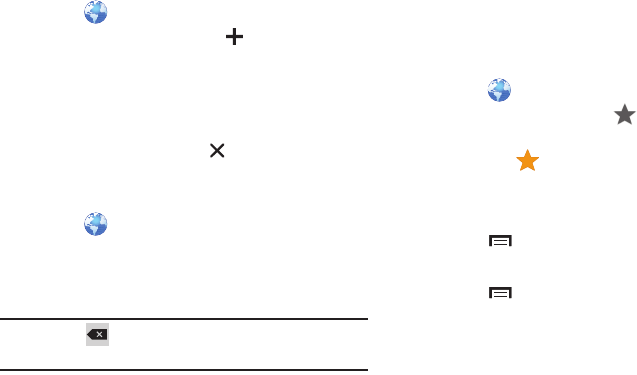
Internet and Social Networking 56
Using Browser Windows
You can have multiple windows open at one time and easily
switch between windows.
1. Touch
Internet
.
2. To open a new window, touch at the top of the
screen.
3. To switch to another open window, touch its tab at the
top of the screen.
4. To delete an open window, touch the tab at the top of
the screen, and then touch .
Entering a URL
Access a website quickly by entering the URL.
1. Touch
Internet
.
2. Touch the
URL
field at the top of the screen, then enter
the URL using the virtual QWERTY keyboard.
As you enter characters, potential matches display.
Note:
Use the
Delete
key to clear the URL field, if
necessary.
3. Touch a match to complete the URL.
– or –
Continue entering characters and touch the
Go
key to
load the page.
Creating Bookmarks
While browsing, bookmark a site to quickly access it later.
1. Touch
Internet
.
2. Browse to a website, touch
Add bookmark
, enter
the required information, and touch
OK
.
A gold star displays on the Bookmarked page.
Internet Menu
While viewing a webpage:
Touch
Menu
for options.
To configure web settings:
Touch
Menu
➔
Settings
.
Follow the on-screen instructions.
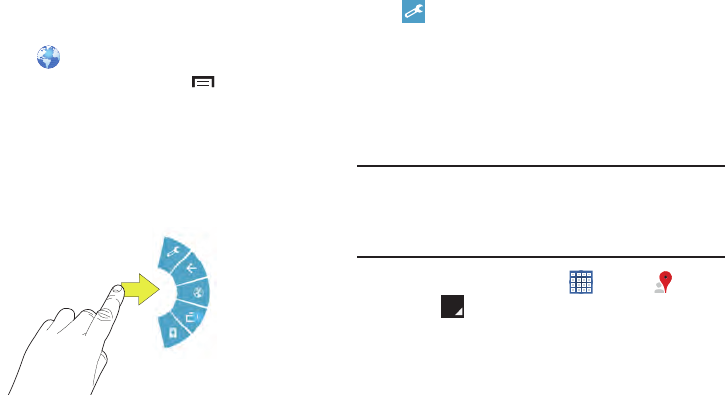
57
Internet Quick Controls
Use Quick Controls to maximize your viewing area while
browsing the internet.
1. Touch
Internet
.
2. While viewing a webpage, touch
Menu
➔
Settings
➔
Labs
, and then touch
Quick controls
to enable the
function.
The Application and URL bars are hidden.
3. Swipe inward from the left or right edge of the screen
to access quick controls.
4. Without lifting your finger, move to an option and then
lift your finger to initiate the option.
5. To cancel, display the Quick controls and touch
Settings
➔
Labs
and touch
Quick controls
to
uncheck it.
Local
Google Local is an application that uses Google Maps and
your location to help you find destinations, such as
restaurants, bars, hotels, attractions, ATMs, and gas stations.
You can also add your own locations.
Note:
You must enable location services to use Local. Some
features require Standalone or Google location services.
For more information, refer to “Location Services” on
page 129.
1. From a Home screen, touch
Apps
➔
Local
.
2. Touch
Choose your location
and touch
My current
location
or
Enter an address
. To enter an address, use
the on-screen keyboard and then touch
OK
.
3. Touch one of the business categories to search for a
particular business.
4. Touch a business in the list to see more details about it.
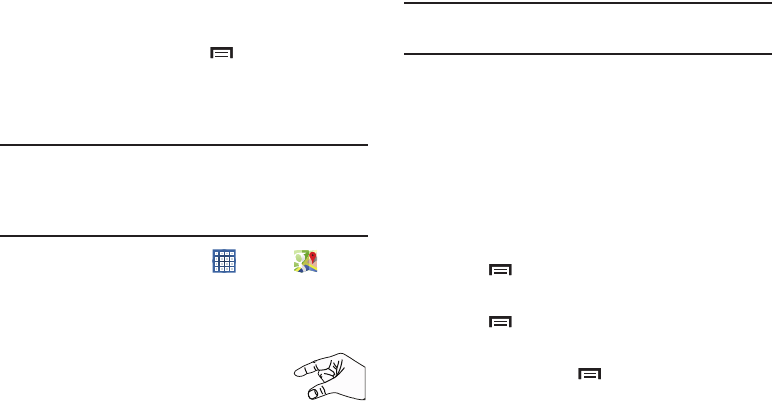
Internet and Social Networking 58
5. Touch your location at the bottom of the Local pop-up
to write or view reviews, check in here, and so on.
6. For more information touch
Menu
➔
Help
.
Maps
Use Google Maps to find your current location, get directions,
and other location-based information.
Note:
You must enable location services to use Maps. Some
features require Standalone or Google location services.
For more information, refer to “Location Services” on
page 129.
From a Home screen, touch
Apps
➔
Maps
.
Navigating the Map
Zooming
•
Double-tap on the screen to zoom in.
•
Use two fingers, such as your index finger and
thumb, to zoom out by making an inward pinch
motion on the screen. To zoom in, make an
outward motion by sweeping your fingers out.
Tip:
Rotate the device to landscape mode for convenient
browsing.
Scrolling
•
Touch and drag on the screen to reposition the map in the display.
Touch
•
Touch an icon on the map to display information about the
location. For example, your location is indicated by a flashing
icon.
Maps Menu
While viewing a map:
Touch
Menu
for options.
To configure Maps settings:
Touch
Menu
➔
Settings
.
Follow the on-screen instructions.
For more information touch
Menu
➔
Help
.
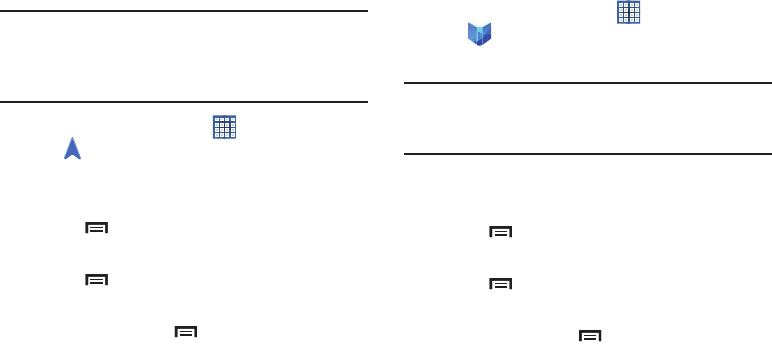
59
Navigation
Use Google Navigation to find a destination and to get
walking or driving directions.
Navigation works best when Wi-Fi is enabled. For more
information, refer to “Turning Wi-Fi On or Off” on page 84.
Note:
You must enable location services to use Navigation.
Some features require Standalone or Google location
services. For more information, refer to “Location
Services” on page 129.
From a Home screen, touch
Apps
➔
Navigation
.
Navigation Menu
While viewing a map:
Touch
Menu
for options.
To configure Navigation settings:
Touch
Menu
➔
Settings
.
Follow the on-screen instructions.
For more information touch
Menu
➔
Help
.
Play Books
Use the Play Books app to read eBooks from the Internet-
based Google Play Books service. Google eBooks is a new
way to discover, buy, and enjoy your favorite books online
and offline.
From a Home screen, touch
Apps
➔
Play Books
.
The Google Play Books main screen displays.
Note:
You may be asked to create or sign on to your Google
account. For more information, refer to “Setting Up Your
Gmail Account” on page 47.
Play Books Menu
From the Play Books main screen:
Touch
Menu
for options.
To configure Play Books settings:
Touch
Menu
➔
Settings
.
Follow the on-screen instructions.
For more information touch
Menu
➔
Help
.
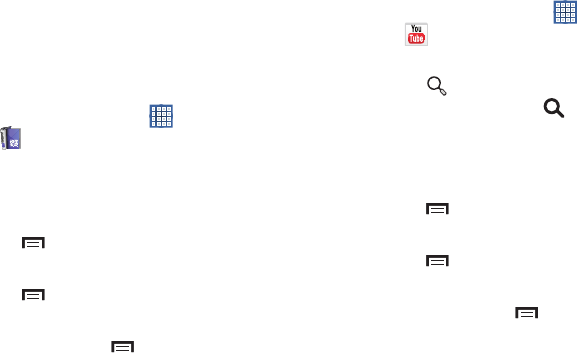
Internet and Social Networking 60
Play Magazines
Google Play Magazines helps you subscribe to your favorite
magazines so you can have them available to read on your
tablet at your leisure.
Play Magazines requires that you log on to your Google
account. For more information, refer to “Accounts” on
page 140.
From a Home screen, touch
Apps
➔
Play Magazines
.
The Play Magazines Welcome screen displays.
Play Magazines Menu
From the Play Magazines main screen:
Touch
Menu
for options.
To configure Play Magazines settings:
Touch
Menu
➔
Settings
.
Follow the on-screen instructions.
For more information touch
Menu
➔
Help
.
YouTube
View and upload YouTube videos right from your device.
From a Home screen, touch
Apps
➔
YouTube
.
To find a YouTube video.
Touch
Search
and use the keyboard to enter a
keyword or phrase. Touch on the keyboard to
initiate the search.
YouTube Menu
From the YouTube main screen:
Touch
Menu
for options.
To configure YouTube settings:
Touch
Menu
➔
Settings
.
Follow the on-screen instructions.
For more information touch
Menu
➔
Help
.
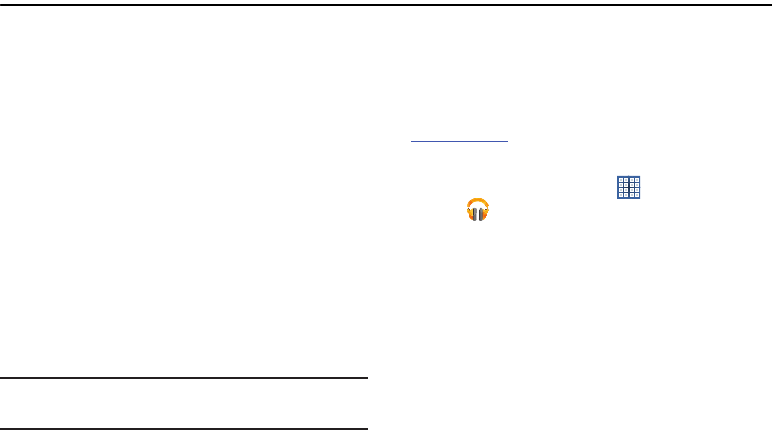
61
Section 6: Music
This section explains how to use the music features of your
device including the Music app, the Music Player, and the
Music Hub.
Listening to Music
You can listen to music by using your device’s built-in
speakers, through a wired headset, or through a wireless
Bluetooth stereo headset.
For more information, refer to “Bluetooth” on page 87.
Press the
Volume Key
on the side of the device to activate on-
screen volume control, then touch and drag on the scale to
set volume. You can also press the Volume Key to adjust
playback volume.
Play Music App
The Play Music app contains a music player that plays
music
and other audio files that you copy from your computer or store
online.
Note:
Some options described in this manual may not be
available until you sign in to your Google account.
Google Play Music
Google Play Music is a new service from Google that gives
you instant access to your personal music collection on the
Internet and your compatible Android devices without the
hassle of wires or syncing. For more information, visit
music.google.com
.
Accessing the Music App
From a Home screen, touch
Apps
➔
Play Music
.
The Play Music app searches your online library and
your device’s internal storage for music and playlists.
This can take from a few seconds to several minutes,
depending on the amount of new music added since
you last opened the application.

Music 62
Changing Library View
You can change the way you view the contents of your
library.
1. Touch
Play Music
.
2. Near the top-left of the Application bar, touch an option
to set whether to view
All music
or
On device only
.
3. Touch an option to set how you view your library.
The choices are:
PLAYLISTS
,
RECENT
,
ARTISTS
,
ALBUMS
,
SONGS
, or
GENRES
.
Play Music Menu
While viewing a Play Music main screen:
Touch
Menu
and follow the on-screen instructions
to use the following options:
•Settings
: Configure Play Music settings.
•Help
: Get more information about the Play Music app.
Play Music Options
Options are available for playing songs, albums, or playlists:
1. Touch
Play Music
.
2. Touch an album or song.
3. Touch the label area under an item to display
options.
Options display depending on the item view.
To play a song:
1. Touch
Play Music
.
2. Touch a song in your library to listen to it.
– or –
While viewing a list of songs, touch next to a song
and touch
Add to queue
.
– or –
While viewing a list of albums, artists, playlists, or
genres, touch the label area under an item and
touch
Add to queue
.
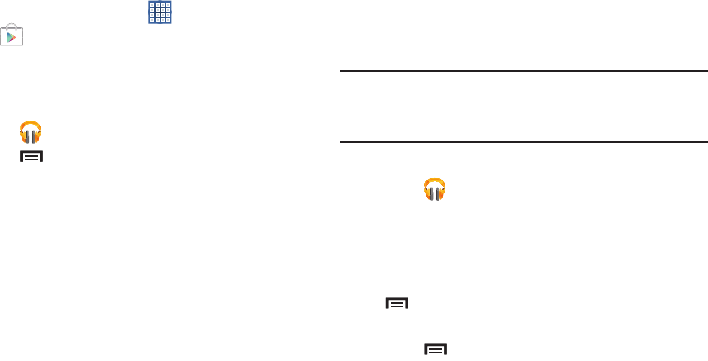
63
Shopping for Music at the Play Store
To visit the Google Play Store where you can find and buy
music:
1. From a Home screen, touch
Apps
➔
Play Store
.
2. Touch
Music
.
The Google Play Store music section displays.
To view information about finding and buying music:
1. Touch
Play Music
.
2. Touch
Menu
➔
Help
.
The Google Play Music help screen displays.
Making Online Music Available Offline
In addition to playing the music that you add to your online
library, you can play music stored on your device’s internal
storage. Then you can listen to music when you have no
Internet connection. To do this, make some of your online
music available offline.
Tip:
You can also copy music directly from your computer to
your device. For more information, refer to “Synchronizing
with Windows Media Player” on page 93.
To make your online music available offline on your device:
1. Touch
Play Music
.
2. Change your library view to Albums, Artists, or
Playlists. For more information, refer to “Changing
Library View” on page 62.
3. If you have signed in to your Google account, touch
Menu
➔
Choose on device music
and touch the
album or playlist you want to make available offline.
4. Touch
Menu
➔
Help
to view information about
listening to music offline.
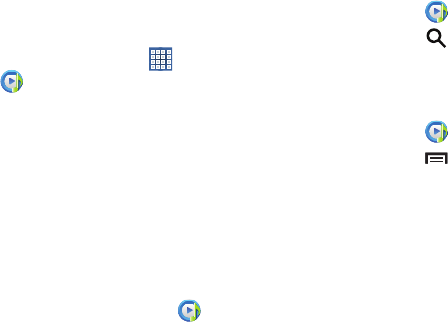
Music 64
Music Player
Music Player plays songs stored on your tablet or an installed
memory card.
To access Music Player:
1. From a Home screen, touch
Apps
➔
Music Player
.
The Music Player application searches your device’s
internal storage or on an installed memory card for
music and playlists. This can take from a few seconds
to several minutes, depending on the amount of new
music added since you last opened the application. It
then displays your music in several ways.
2. Touch a tab, such as
Songs
,
Playlists
,
Albums
, and so
on, to change the way you view the contents of your
library.
3. Touch the Music application icon at the top-left of
the Application bar to return to the previous Music
screen.
Searching for Music
To find music in your library:
1. Touch
Music Player
.
2. Touch
Search
and use the keyboard to type the
name of an artist, album, or song.
Music Player Options and Settings
To use Music Player options and configure settings:
1. Touch
Music Player
.
2. Touch
Menu
to display the following options:
• Delete
: Delete a song, an album, or every song or album.
• Set as alarm tone
: Choose a song and touch
Set
to use the
song as an alarm tone.
• Scan for nearby devices
: Discover and connect directly to
nearby devices.
•Settings
: The following settings display:
Advanced
–
SoundAlive
: View and set SoundAlive options.
–
Play speed
: Decrease or increase play speed.
–
Lyrics
: Display the lyrics of the song, if available.
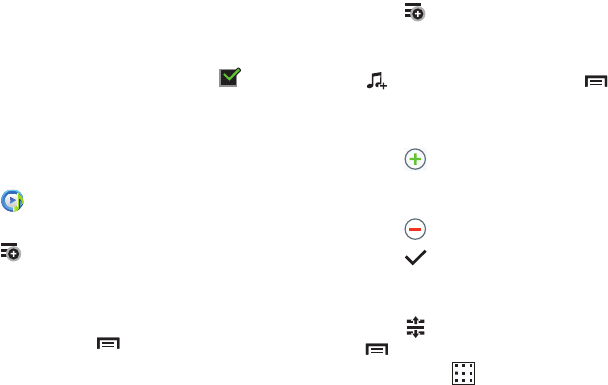
65
–
Music auto off
: Set the option Off or set your music to turn off
automatically by touching one of the time values.
Music menu
–
Music menu
: Enable or disable the music display options that
appear on the main music screen. A check mark
next to
an option means that it is enabled.
•End
: Close the Music Player app.
Managing Playlists
To create, manage, or delete a playlist:
Touch
Music Player
.
Creating a Playlist
Touch
Add to playlist
➔
Create playlist
and use the
keyboard to enter a name for the playlist.
Renaming a Playlist
1. Touch the
Playlists
tab.
2. Touch a playlist, touch
Menu
➔
Rename playlist
and use the keyboard to enter a new name for the
playlist.
Adding Songs to or Removing Songs from Playlists
1. Touch
Add to playlist
and touch a playlist.
– or –
Touch
Playlists
, touch a playlist, and then touch
Add music
(landscape mode) or
Menu
➔
Add music
(portrait mode).
All songs are displayed.
2. Touch
next to each song you want to add or next
to
Add all
to add all songs to the playlist.
– or –
Touch
to remove a song from the playlist.
3. Touch
Done
to save the playlist.
Changing the Order of a Playlist
1. Touch the
Playlists
tab and touch a playlist.
2. Touch
Change order
(landscape mode) or
Menu
➔
Change order
(portrait mode).
3. Touch the grid for an entry and drag the entry to a
new position in the list.
4. Touch
Done
to change the order and save the playlist.

Music 66
Playing a Playlist
1. Touch the
Playlists
tab.
2. Touch
Favorites
,
Most played
, or
Recently added
, or
touch a playlist title that you created.
3. Touch a song to start playing the playlist at that song.
Deleting a Playlist
1. Touch the
Playlists
tab and touch a playlist.
2. Touch
Remove
in the Application bar.
3. Touch the box next to a playlist title, touch
Remove
, and then touch
OK
.
Playing Music
To play a song:
1. Touch
Music Player
.
2. Touch a song or touch an album or genre and then
touch a song in the list of songs on the album.
The song you touch starts to play. The tracks in the
current list play in order until you reach the end of the
list (unless you choose a repeat option). Otherwise,
playback stops only if you stop it, even when you
switch applications.
Accessing the Music Player
If you navigate away from the Music Player application and
music is playing, the Music notification icon is displayed
in the System Bar.
You can change songs or easily return to the Music Player:
1. Touch the top of the screen and swipe downward.
The Status Details screen displays.
2. Touch the song thumbnail to display the Music Player.
You can also pause and resume playback and skip to
the next or previous song in the panel. For more
information, refer to “Notifications” on page 24.
Music Player Controls
When a song is playing, the Music Player screen displays
and
various controls are available.
1. Touch
Music Player
.
2. Touch a song or playlist to begin playback.
The music player displays below (portrait mode) or to
the right (landscape mode) of the music listing.
3. Touch the song thumbnail to enlarge the music player.
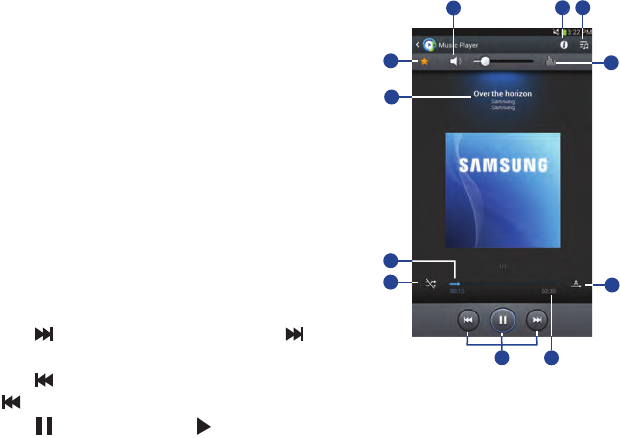
67
Music Player Screen
During playback, use the sound and playlist controls:
1.
Volume
: Touch to toggle Silent and Sound mode, then
touch and drag on the scale to set volume. You can
also press the Volume Key on the side of the device to
adjust playback volume.
2.
Info
: Touch to view information about the current song.
3.
List
Mode
: Touch to switch to the list of songs.
4.
SoundAlive
: Touch to view and set SoundAlive options.
5.
Repeat
: Touch to repeat the current song, repeat all
songs, or disable repeat mode.
6.
Time Indicators
: Indicates elapsed time and total song
length in minutes and seconds.
7.
Playback Controls
: These buttons control the playback
of songs:
•
Touch to advance to the next song. Touch and hold
to scan forward through the current song.
•
Touch to go back to the previous song. Touch and hold
to scan backward through the current song.
•
Touch to pause playback. Touch to resume
playback.
9
8
76
5
4
3
12
11
10

Music 68
8.
Shuffle
: When enabled, songs play in random order.
When disabled, songs play in the order they appear in
List view.
9.
Progress Bar
: Touch and drag the end of the progress
bar to scan forward or backward through the current
song.
10.
Song Title
/
Artist
/
Album
: Identifies the song, artist,
and album.
11.
Favorite
: Touch the star to mark the current song
as a favorite.
Options While Playing a Song
There are various options and controls available while a song
is playing:
1. Touch
Music Player
, touch a song or an album,
and then a song.
2. Touch the music player to enlarge it.
3. Touch
Menu
to display the following options:
•Add to playlist
: Add the song to a new playlist or an existing
playlist.
• Via Bluetooth
: Play the current song by using a Bluetooth
device.
• Set as alarm tone
: Use the current song as an alarm tone.
• Scan for nearby devices
: Discover and connect directly to
nearby devices.
•Settings
: Displays Music Player settings. For more information,
refer to
“Music Player Options and Settings”
on
page 64.
•End
: This option returns you to the home screen.

69
Section 7: Photos and Video
This section explains how to use your device’s built-in
camera and camcorder, the Video Player app to view and
manage videos, and the Gallery app to view, capture, and
manage photos and videos. It also contains an overview of
the Video Player and Gallery apps.
Camera
Use your device’s built-in camera and camcorder to take
photos and record videos.
To access the Camera:
1. From a Home screen, touch
Apps
➔
Camera
.
If a memory card is inserted, the Storage location
pop-up displays.
2. Touch
OK
to change the storage location to memory
card.
– or –
Touch
Cancel
to use the device storage for storing
pictures and videos.
Note:
If memory card storage is used, photos are stored in the
/storage/sdcard0/DCIM/Camera folder as jpg files. For
more information, refer to “My Files” on page 104.
The Camera screen displays.
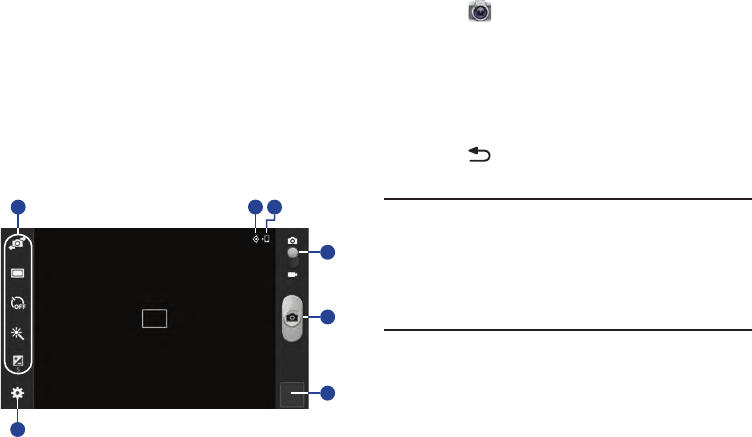
Photos and Video 70
Camera Screen
The following items can be found on the Camers screen as
illustrated:
1. Settings Shortcuts
2. GPS Active
3. Storage Indicator
4. Mode
5. Camera Button
6. Image Viewer
7. Settings
Taking Photos
To take a photo:
1. Touch
Camera
.
2. Using the display as a viewfinder, compose your photo
by aiming the lens at the subject.
To configure settings, see “Camera Settings” on
page 71.
3. To take the photo, touch the
Camera
button.
4. Touch
Back
to leave the Camera and display the
previous screen.
Important!
Do not take photos of people without their
permission.
Do not take photos in places where cameras are
not allowed.
Do not take photos in places where you may
interfere with another person’s privacy.
7
1
6
5
4
23
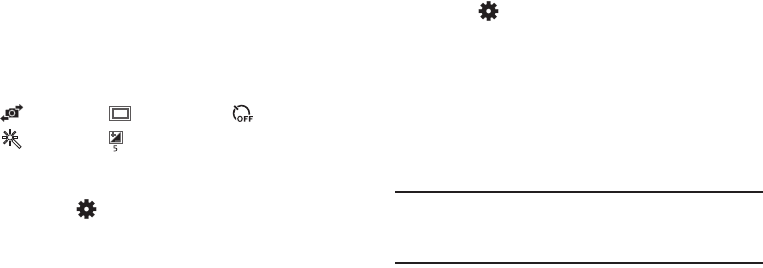
71
Camera Settings
Before you start taking photos, use the camera settings to
configure the camera for best results. Camera settings are
represented by icons on the left side of the screen.
Editing Camera Settings Shortcuts
The first five icons are actually shortcuts to camera settings.
These five shortcuts can be customized to fit your
preference.
Self-portrait
,
Shooting mode
,
Timer
Effects
, and
Brightness
are default settings
shortcuts.
To customize these shortcuts:
1. Touch
Settings
➔
Edit shortcuts
.
– or –
Touch and hold any of the shortcut icons to edit them.
2. Touch and hold a setting, then drag and drop it on one
of the five settings shortcuts to the left. The replaced
setting shortcut displays in the edit list.
Configuring Camera Settings
To configure Camera settings:
While in Camera mode, touch a settings shortcut or
touch
Settings
to configure the following camera
settings:
• Edit shortcuts
: Customize your settings shortcuts. For more
information, refer to
“Editing Camera Settings
Shortcuts”
on page 71.
• GPS tag
: Touch to switch the GPS tag on or off.
•Self-portrait
: Touch to switch to the front-facing camera lens
and take a photo of yourself.
Warning!
If the battery is low, the flash is not available. For
more information, refer to “Charging the Battery” on
page 6.
Photos and Video 72
• Shooting mode
: Choose an automatic shooting mode, from:
–
Single shot
: Take a single photo.
–
Panorama
: Touch the Camera button to take a photo, then use
the on-screen guideline to move the viewfinder and take the
next 7 shots automatically.
–
Share shot
: Share photos with other users via Wi-Fi Direct. A
Wi-Fi Direct connection is required.
–
Buddy photo share
: Take and share photos with friends via
face detection.
–
Smile shot
: Touch the Camera button to automatically focus on
the subject’s face and take the photo.
• Effects
: Apply an effect to photos.
•Scene mode
: Choose a mode to match the kind of pictures
you want to take.
•Brightness
: Use the slider to set the brightness value.
•Timer
: Set a delay time to wait between touching the Camera
button and taking a photo.
•Resolution
: Choose a size for the photo.
• White balance
: Set the light source.
• Metering
: Select a method for measuring light.
• Guidelines
: Enable or disable an on-screen grid to aid in photo
composition.
• Image quality
: Choose a quality setting for photos.
•Storage
: Set whether to store your photos on your device or on
your memory card, if one is installed.
• Reset
: Set all Camera settings to the defaults.
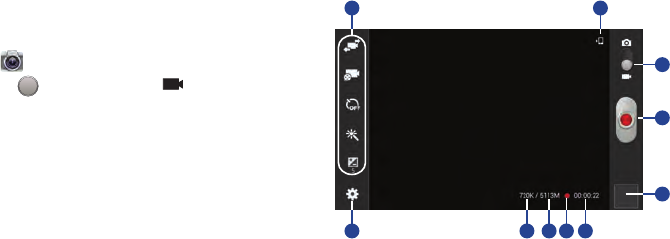
73
Camcorder
Use your device’s built-in Camcorder to record high-
definition video in 1080p resolution.
1. Touch
Camera
.
2. Slide the
Mode
button to the
Camcorder
setting.
The Camcorder screen displays.
Camcorder Screen
The following items can be found on the Camcorder screen
as illustrated:
1. Settings Shortcuts
2. Storage Indicator
3. Mode
4. Record Button
5. Image Viewer
6. Elapsed Time
7. Recording Indicator
8. Available Storage
9. File Size
10. Settings
10 9 8 7 6
2
1
5
4
3
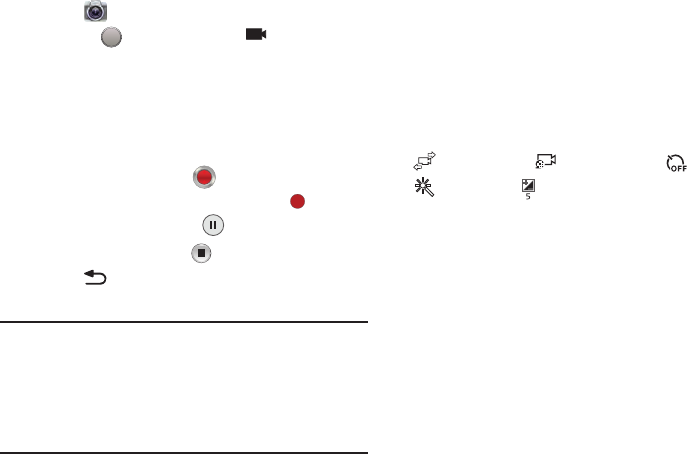
Photos and Video 74
Recording Videos
1. Touch
Camera
.
2. Slide the
Mode
button to the
Camcorder
setting.
3. Using the display as a viewfinder, compose your shot
by aiming the lens at the subject.
To configure settings, see “Camcorder Settings” on
page 74.
4. To start recording, touch
Record
.
During recording, the
Recording Indicator
flashes.
5. To pause recording, touch
Pause.
6. To stop recording, touch
Stop
.
7. Touch
Back
to leave the Camcorder and display
the previous screen.
Important!
Do not take videos of people without their
permission.
Do not take videos in places where cameras are
not allowed.
Do not take videos in places where you may
interfere with another person’s privacy.
Camcorder Settings
Before you start taking videos, use the camcorder settings to
configure the camcorder for best results. Camcorder settings
are represented by icons on the left side of the screen.
Editing Camcorder Settings Shortcuts
As with the camera, the first five icons are actually shortcuts
to camcorder settings. These five shortcuts can be
customized to fit your preference.
Self-recording
,
Recording mode
,
Timer
Effects
, and
Brightness
are default settings
shortcuts.
To customize these shortcuts, see “Editing Camera Settings
Shortcuts” on page 71.

75
Configuring Camcorder Settings
To configure Camcorder settings:
While in Camcorder mode, touch a settings shortcut or
touch
Settings
to configure the following
Camcorder settings:
• Edit shortcuts
: Customize your settings shortcuts. For more
information, refer to
“Editing Camera Settings
Shortcuts”
on page 71.
• Self-recording
: Touch to switch to the front-facing camera
lens and record a video of yourself.
• Recording mode
: Set a recording mode. Options are:
Normal and Limit for email, which limits the size of the video to
50 megabytes.
• Effects
: Apply an effect to videos.
•Brightness
: Use the slider to set the brightness value.
•Timer
: Set a delay to wait between touching Record and
starting recording.
•Resolution
: Set a size for the video.
• White balance
: Set the light source.
• Guidelines
: Enable or disable an on-screen grid to aid in video
composition.
• Video quality
: Choose a quality setting for videos.
•Storage
: Set whether to store your videos on your device or on
your memory card.
• Reset
: Set all Camera settings to the defaults.
Using the Image Viewer
After taking a photo or recording a video, use the Image
Viewer to view or play, share, delete, or edit your photos and
videos.
1. Touch
Image Viewer
to view the photo and videos.
2. Touch the screen to show or hide Image Viewer
options.
3. For photos, touch the screen with two fingers or
double-tap on the screen to zoom all the way in or out.
For more information, refer to “Pinch” on page 24.
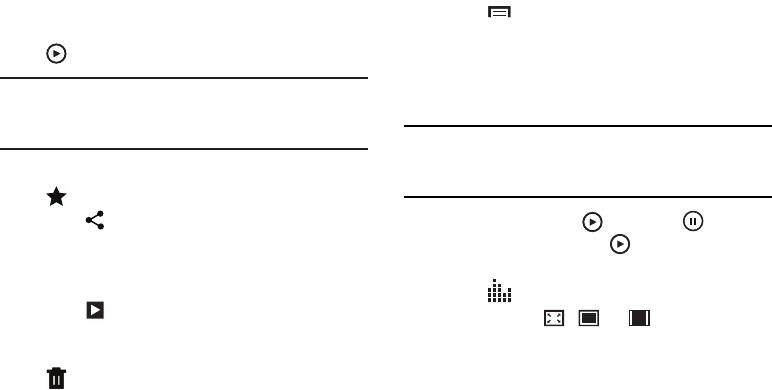
Photos and Video 76
4. Sweep across the screen to display the next or
previous photo or video. (Videos are indicated by the
Play
button.)
Tip:
The current photo or video is outlined in the thumbnails at
the bottom of the screen. Touch a thumbnail to view the
photo or video it represents.
5. To set the photo or video as a favorite, touch
Favorites
.
6. Touch
Share
to share the photo or video. Touch an
option, such as Bluetooth, and follow the on-screen
instructions. After using this option, the most recent
Share option is displayed in the Application Bar.
7. Touch
Slideshow
to display a slide show of the
available pictures and videos.
8. To delete the photo or the video being displayed, touch
Delete
.
9. Touch
Menu
to select
Set as
to assign a photo as a
Contact photo or a Home screen, Lock screen, or Home
and lock screens wallpaper.
For more information, refer to “Viewing Photos and
Videos” on page 80.
Note:
Photos and videos are stored in the /storage/sdcard0/
DCIM/Camera folder as jpg and mp4 files. For more
information, refer to “My Files” on page 104.
10. To play a video, touch
Play
. Touch
Pause
to
pause the video and touch
Resume
to resume
playing the video.
Touch
SoundAlive
to set the sound quality.
Touch the icon ( , , or ) in the lower left
corner of the display screen while the video is playing
to change the Display Mode from original size to full
screen in ratio or full screen.
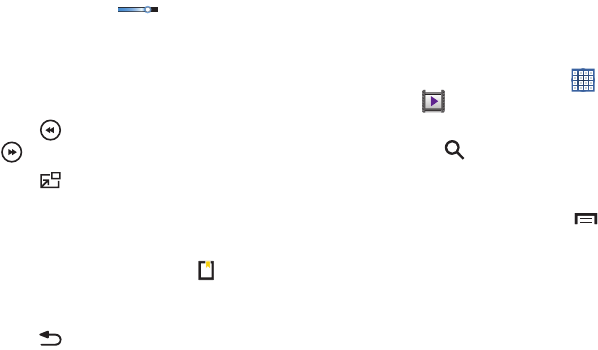
77
Touch and drag the white dot on the progress
bar to fast forward or rewind the video. Touch the left
end of the progress bar to restart the video. Touch the
right end of the progress bar to end the video playback.
– or –
Touch
Rewind
to restart the video or
Fast Forward
to end the video.
11. Touch
Pop up play
to play a video as a small
pop-up while viewing another screen. Touch and drag
the pop-up video to the desired location on the screen.
Double-tap the pop-up to return to full screen mode.
12. While the video is playing, touch
Bookmark
to
mark your favorite areas of the video. A yellow mark
displays on the progress bar.
13. Touch
Back
to return to the Camera or Camcorder
screen.
Video Player
Use Video Player to view and manage videos stored on your
tablet.
1. From a Home screen, touch
Apps
➔
Video Player
.
2. Touch the
Thumbnails
,
List
, or
Folders
tab.
3. Touch
Search
and use the keyboard to enter a
search term. The current folder is searched and results
are displayed. Touch
X
to clear the search field.
4. While viewing the list, touch
Menu
for options:
•List by
: Display videos by Name (default), Date, Size, or Type.
•Share via
: Share the video. Touch an option, such as
Bluetooth, and follow the on-screen instructions.
•Delete
: Touch videos to select them for deletion or touch
Select all
to delete all videos.
• Auto play next
: Touch to enable or disable automatic playing of
videos in the order they appear.
• Scan for nearby devices
: Discover and connect directly to
nearby devices.
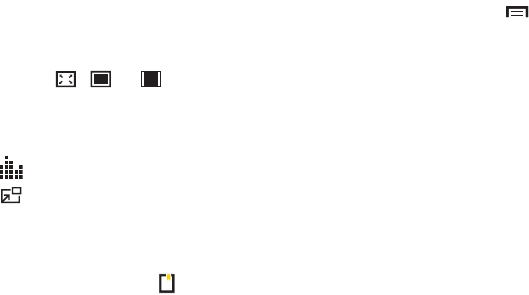
Photos and Video 78
5. Touch a video to play it. While playing a video, touch
the screen to display or hide on-screen playback
controls.
6. Touch the icon ( , , or ) in the lower left
corner of the display screen while the video is playing
to change the Display Mode from original size to full
screen in ratio or full screen.
7. Touch
SoundAlive
to set the sound quality.
8. Touch
Pop up play
to play a video as a small
pop-up while viewing another screen. Touch and drag
the pop-up video to the desired location on the screen.
Double-tap the pop-up to return to full screen mode.
9. While the video is playing, touch
Bookmark
to
mark your favorite areas of the video. A yellow mark
displays on the progress bar.
10. During playback, touch
Menu
for options:
•Share via
: Share the video. Touch an option, such as
Bluetooth, and follow the on-screen instructions.
•Trim
: Use the sliders at the bottom of the screen to trim the
video.
• Via Bluetooth
: Turn Bluetooth on to use Bluetooth services.
• Video auto off
: Set the option Off or set your video to turn off
automatically by touching one of the time values.
• Scan for nearby devices
: Discover and connect directly to
nearby devices.
•Settings
: Touch this option to view the following:
–
Play speed
: Touch and drag the slider to decrease or increase
play speed.
–
Subtitles
: View subtitles for the video, if available.
–
Auto play next
: Enable or disable auto play of the next video.
•Details
: Provides details about the video, such as Name, Size,
Resolution, and so on.
For more information, refer to “Playing Videos” on page 82.
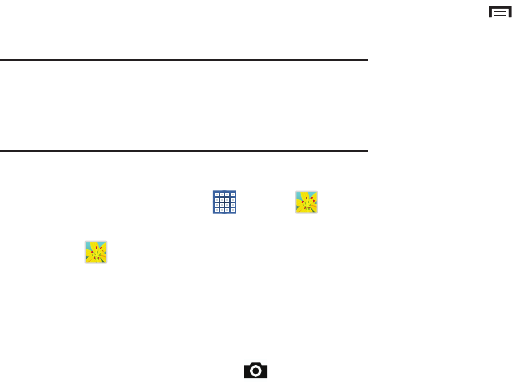
79
Gallery
Use Gallery to view, capture, and manage photos and videos.
Note:
Photos and videos are stored in the /storage/sdcard0/
DCIM/Camera folder, photos as jpg files and videos as
mp4 files. For more information, refer to “My Files” on
page 104.
To access Gallery:
From a Home screen, touch
Apps
➔
Gallery
.
Selecting Photos and Videos to View
1. Touch
Gallery
.
All albums display.
2. Choose items to display by making selections from the
menus in the Application bar:
Albums
,
Time
,
Locations
,
Person
,
Group
, and
Favorites
.
3. To launch the Camera app, touch
Camera
.
4. Touch the icon next to Camera to change the way your
albums are displayed (
Grid
,
Timeline
, or
Spiral
).
5. Touch
Menu
to display the following options:
•Slideshow
: View a slideshow of the available pictures and
videos.
•New album
: Create a new album. Use the keyboard to enter a
name for the album.
• Hidden Items
: Touch this icon to show items that have been
hidden.
•View by
: View content from all sources or set a single source,
such as in your device.
•Select album:
Touch one or more albums or groups that you
want to share, share, or delete.
• Scan for nearby devices
: Discover and connect directly to
nearby devices.
• Settings
: Set your account sync settings.
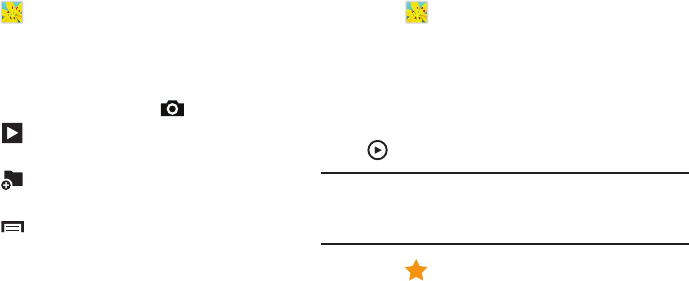
Photos and Video 80
Viewing Groups of Photos and Videos
1. Touch
Gallery
.
2. Touch a category and then a group to view it.
Thumbnails for each photo and video in the group
display.
3. To launch the Camera app, touch
Camera
.
4. Touch
Slideshow
to view a slideshow of the
available pictures and videos.
5. Touch
New album
to create a new album. Use the
keyboard to enter a name for the album.
6. Touch
Menu
for these options:
• Select item:
Touch one or more items that you want to share,
delete, or use for a slideshow.
•Hidden items
: View hidden photos or videos.
Viewing Photos and Videos
1. Touch
Gallery
.
2. Touch a category and then a group to view it, and then
touch a photo or video thumbnail.
3. Touch the screen to show or hide Gallery options.
4. Sweep across the screen to display the next or
previous photo or video. (Videos are indicated by the
Play
button.)
Tip:
The current photo or video is outlined in the thumbnails at
the bottom of the screen. Touch a thumbnail to view the
photo or video it represents.
5. Touch to assign this photo or video as a Favorite.

81
6. Touch
Share via
to share the photo or video. Touch
an option, such as Bluetooth, and follow the on-screen
instructions.
7. Touch the to choose from Start slideshow and
Slideshow settings.
8. To delete the photo or video being displayed, touch
Delete
.
9. Touch
Menu
to display the following options for
photos:
• Face tag
: Set whether to look for a face in this picture.
•Copy to clipboard
: Copy the current photo to the clipboard.
•Rotate left
: Allows you to rotate the photo counterclockwise
90 degrees.
• Rotate right
: Allows you to rotate the photo clockwise
90 degrees.
•Crop
: Allows you to crop the image. Touch and drag the crop
box or the sides or corners of the crop box to create the crop
area, then touch
Done
. Touch
X
to stop without cropping the
photo.
•Edit
: Use Photo Editor or Paper Artist to edit your photo.
•Set as
: Assign the photo as a Contact photo or a Home screen,
Lock screen, or Home and lock screens wallpaper.
• Buddy photo share
: Detect the face in this picture and email
that person.
•Print
: Print the current photo to a Samsung printer.
•Rename
: Enter an new file name.
• Scan for nearby devices
: Discover and connect directly to
nearby devices.
•Details
: Provides details about the photo, such as title, time
taken, size, and so on.
The options for videos that are not playing are:
•Rename
: Enter an new file name.
• Scan for nearby devices
: Discover and connect directly to
nearby devices.
•Details
: Provides details about the video such as Title, Time,
Duration, and so on.
For menu options while a video is playing and other
video options, see “Video Player” on page 77.
10. Touch
Back
to return to the category screen.
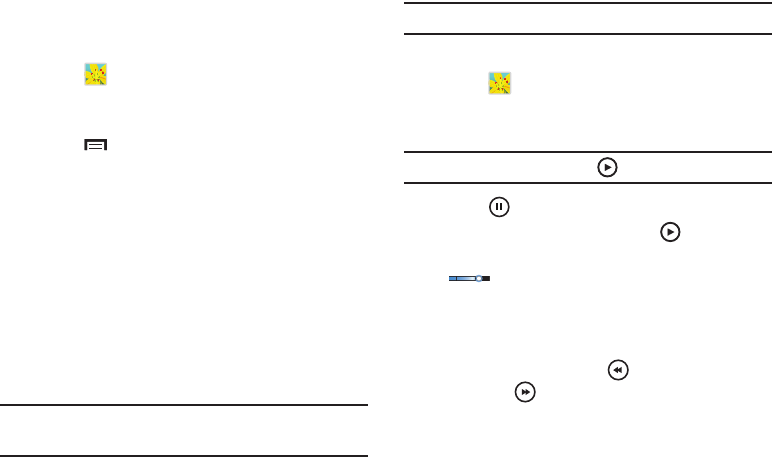
Photos and Video 82
Setting a Picture As
You can use the photos you take as a contact’s photo or as
wallpaper for the Home or Lock screen:
1. Touch
Gallery
.
2. Touch a category and then a group to view it, and then
touch a photo to select it.
3. Touch
Menu
➔
Set as
.
4. Touch
Contact photo
and then touch a contact entry.
– or –
Touch
Home screen
,
Lock screen,
or
Home and lock
screen
.
A crop photo screen displays.
5. Touch and drag the crop box or the sides or corners of
the crop box to create the crop area, then touch
Done
to save the cropped photo as the contact’s icon or
wallpaper. Touch
Cancel
to stop without cropping the
photo.
Tip:
To remove a contact photo, see “Updating Contacts” on
page 41.
Tip:
To change wallpaper, see “Wallpapers” on page 32.
Playing Videos
1. Touch
Gallery
.
2. Touch a category and then a group to view it, and then
touch a video thumbnail to play the video.
Note:
Videos are marked with a
Play
button.
3. Touch
Pause
to pause the video.
4. To resume playing the video, touch
Resume
.
5. To fast forward or rewind the video, touch and drag the
white dot on the progress bar. To restart the
video, touch the left end of the progress bar. To end the
video playback, touch the right end of the progress bar.
– or –
To restart the video, touch
Rewind
or to end the
video touch
Fast Forward
.
For more information, refer to “Video Player” on
page 77.

83
Sharing Photos and Videos
Share photos and videos with your friends.
1. Touch
Gallery
.
2. Touch a category and then a group to display
thumbnails.
3. Touch
Menu
➔
Select item
.
4. Touch one or more photos and videos to highlight them
for sharing.
5. Touch
Share via
.
6. Touch an option, such as Email, and follow the
on-screen instructions.

Connections 84
Section 8: Connections
Your device includes features to connect to the internet and
to other devices by using Wi-Fi, Bluetooth, or a USB cable.
Wi-Fi
Wi-Fi is a wireless networking technology that provides
access to local area networks. Use your device’s Wi-Fi
feature to:
•
Access the internet for browsing or to send and receive email.
•
Access your corporate network.
•
Use hotspots provided by hotels or airports while traveling.
Wi-Fi communication requires access to an existing Wireless
Access Point (WAP). WAPs can be Open (unsecured, as with
most hotspots) or Secured (requiring you to provide login
credentials). Your device supports the 802.11 a/b/g/n
Wi-Fi protocol.
Configuring Wi-Fi Settings
For more information about configuring your device’s
Wi-Fi settings, see “Wi-Fi” on page 116.
Finding Wi-Fi Networks
You can have your device automatically notify you of
available networks. For more information, refer to “Advanced
Settings” on page 117.
Turning Wi-Fi On or Off
Turn your device’s Wi-Fi service on or off. When you turn
Wi-Fi service on, your device automatically searches for
available, in-range WAPs (Wireless Access Points).
Turning Wi-Fi On
1. From any screen, touch the top of the screen and
swipe downward.
The Status Details screen displays.
2. Touch
Wi-Fi
to turn Wi-Fi On.
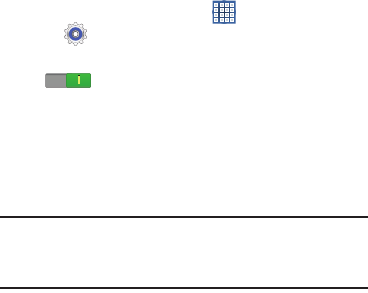
85
Turning Wi-Fi Off
1. From any screen, touch the top of the screen and
swipe downward.
The Status Details screen displays.
2. Touch
Wi-Fi
to turn Wi-Fi Off.
Scanning and Connecting to a Wi-Fi Network
When you turn on Wi-Fi, your device searches for available
Wi-Fi connections, then displays them on screen.
1. From any screen, touch the top of the screen and
swipe downward.
The Status Details screen displays.
2. Touch
Wi-Fi
to turn Wi-Fi On. Your device automatically
scans for available Wireless Access Points.
3. When the scan is complete, touch a Wi-Fi network to
connect. If the Wi-Fi network is open, your device
automatically connects. If the Wi-Fi network is
secured, enter the password at the prompt to connect.
Adding a Wi-Fi Network Manually
1. From a Home screen, touch
Apps
➔
Settings.
2. Under
Wireless and network
, on the Wi-Fi tab, touch the
OFF / ON
icon to turn Wi-Fi on.
3. Touch
Add Wi-Fi network
, then enter network
information:
• Network SSID
: Enter the name of the Wi-Fi Wireless Access
Point (WAP).
• Security
: Select the type of security used by the WAP.
Note:
Depending on the Security protocol used by the WAP,
additional network information may be required, such as
a Password.
• Password
: If the WAP is secured, enter the password or hex
key.
4. Touch
Save
to save the settings.

Connections 86
Wi-Fi Direct
Wi-Fi Direct allows device-to-device connections so you can
transfer large amounts of data over a Wi-Fi connection.
1. From a Home screen, touch
Apps
➔
Settings
➔
Wi-Fi
.
2. Touch the
OFF / ON
icon to turn Wi-Fi on.
3. Touch
Wi-Fi Direct
to display available devices.
Your device begins to search for other devices enabled
with Wi-Fi direct connections.
4. Enable Wi-Fi Direct (similar to Steps 1, 2, and 3) on the
device to which you want to connect.
5. Once the device you want to connect to is displayed,
touch on it.
An Invitation to connect displays on the device to which
you want to connect.
6. On that device, touch
Accept
.
You have 30 seconds to touch
Accept
on the device to
which you want to connect for the connection to be
made.
Once connected, the other device will show as
Connected
in your list of Wi-Fi Direct devices and the
icon will display in the System Bar.

87
Sharing Information with Connected Device
To share videos, photos, or other information with the
connected device, follow these steps:
1. View the information that you want to share. For
example, if you want to share a photo, find the photo in
your camera viewer or
My Files
folder, then touch the
Share,
Share via,
or
Send via
option.
2. Touch the
Wi-Fi Direct
option.
The Wi-Fi Direct settings screen displays, Wi-Fi Direct
is turned on, and your device scans for other devices.
3. Touch a connected device name. For example,
Android_XXXX.
4. The other device displays a pop-up that indicates it is
receiving the file.
The file is transferred and can be found in
My Files
in
the ShareViaWifi folder.
Note:
Depending on the other device model, the prompts and
shared folder information may differ.
Bluetooth
Bluetooth is a short-range wireless communications
technology for exchanging information over a distance of
about 30 feet.
You do not need to line up the devices to send information
with Bluetooth. If the devices are in range, you can exchange
information between them, even if they are in different
rooms.
Configuring Bluetooth Settings
Configure your device’s Bluetooth settings. For more
information, refer to “Bluetooth” on page 118.
Turning Bluetooth On or Off
To turn Bluetooth on or off:
1. From a Home screen, touch
Apps
➔
Settings
.
2. Under
Wireless and network
, on the Bluetooth tab,
touch the
OFF / ON
icon to turn Bluetooth on or
off.
Note:
When Bluetooth is on, the
Bluetooth
icon displays in
the Status Bar.
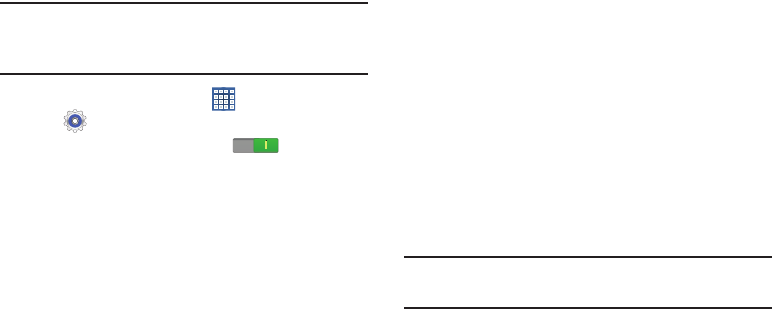
Connections 88
Pairing with a Bluetooth Device
Search for a Bluetooth device and pair with it, to exchange
information between your device and the target device.
Tip:
After pairing, your device and the target device recognize
each other and exchange information without having to
enter a passcode or PIN.
1. From a Home screen, touch
Apps
➔
Settings
.
2. On the Bluetooth tab, touch the
OFF / ON
icon
to turn Bluetooth on.
3. Enable the target device’s discoverable or visible
mode.
4. Touch the
Bluetooth
tab and then touch
Scan
. Touch
Stop
at any time to stop scanning.
5. From the list of found devices, touch the target device,
then follow the prompts to complete the pairing:
•
If the target device requires a PIN, enter a PIN for the target
device and touch
OK
. When prompted, enter the PIN on the
target device.
•
If the device allows automatic or smart pairing, your device
attempts to pair with the device automatically. Follow the
prompts on your device and the target device to complete the
pairing.
Sharing Data with a Bluetooth Device
To send data to a Bluetooth device:
1. Select a file or item from an appropriate application.
2. Select an option for sharing data with the Bluetooth
feature.
Note:
The method for selecting an option may vary by data
type.
3. Search for and pair with a Bluetooth device. For more
information, refer to “Pairing with a Bluetooth Device”
on page 88.

89
Receiving Data from a Bluetooth Device
To receive data from a Bluetooth device:
1. Turn Bluetooth on. For more information, refer to
“Turning Bluetooth On or Off” on page 87.
Note:
To select the length of time that your device will be
visible, select
Menu
➔
Visibility timeout
.
2. Pair with the Bluetooth device from which you want to
receive data. For more information, refer to “Pairing
with a Bluetooth Device” on page 88.
A Bluetooth authorization request pop-up displays
when a Bluetooth device sends data to your device.
3. Select
Accept
to confirm that you are willing to receive
data.
A File received message displays.
Received data is saved to the Bluetooth folder. If you receive
a contact, it is saved to your contacts automatically.
Managing Downloads
Files, apps, and other items you download in Internet, Gmail,
Email, or in other ways, are stored on your tablet’s internal
storage. You can use the Downloads app to view, reopen, or
delete what you have downloaded.
To manage the demands on their networks or to help you
avoid unexpected charges, some mobile networks place
restrictions on the size of the files you can download. When
you are connected to such networks, and you try to
download an oversized-file, you are asked or required to
delay downloading the file until the next time you are
connected to a Wi-Fi network. At that time, the download
resumes automatically. The Downloads app can also be used
to view and manage these queued files.
Downloaded files are stored in the Download directory in
your tablet’s internal storage. You can view and copy files
from this directory when connected to a computer with a
USB cable.
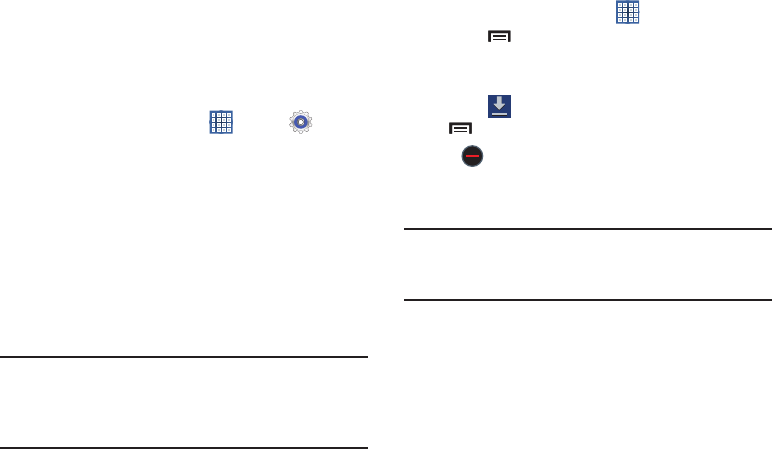
Connections 90
Uninstalling an App
Apps come pre-installed on your device and you can
download additional apps from Google Play. If you decide to,
you can uninstall apps you downloaded from Google Play and
other sources.
There are several ways to uninstall an app:
1. From a Home screen, touch
Apps
➔
Settings
➔
Application manager
.
2. Touch the
DOWNLOADED
tab.
3. Touch the app you want to uninstall.
4. Touch the
Uninstall
button.
A pop-up displays the message
Application will be
uninstalled.
5. Touch
OK
to confirm you want to uninstall the app.
You can also use Google Play to uninstall apps you
downloaded from there (see “Play Store” on page 106).
Tip:
To uninstall updates to pre-installed apps, touch the app
and touch
Uninstall updates
. A pop-up displays the
message
All updates to this Android system app will be
uninstalled
. Touch
OK
to uninstall the updates.
To uninstall an app from the Apps screen:
1. From a Home screen, touch
Apps
.
2. Touch
Menu
➔
Uninstall
to display the Uninstall
screen.
– or –
Touch
Downloaded
and then touch
Menu
➔
Uninstall
.
A appears on Apps that can be uninstalled.
3. Touch an app’s icon and then touch
OK
to uninstall and
remove the app from your tablet.
Note:
You cannot uninstall the apps that are included with
Android. You can only uninstall the apps you have
downloaded.
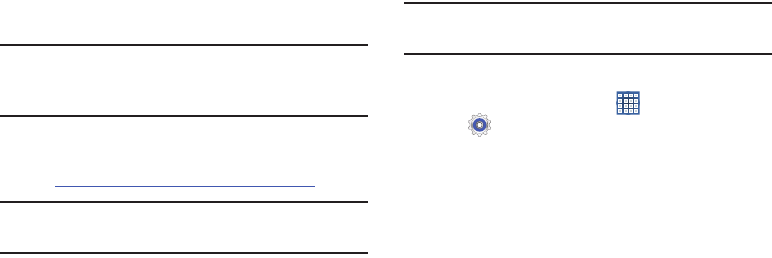
91
Kies Via Wi-Fi
Samsung Kies is a software that enables you to update your
device firmware, synchronize files, and transfer data to and
from your device directly by connecting to the PC.
Note:
Some features will be supported through the System
Updates feature in the future. For more information,
refer to “Software Update” on page 147.
To learn more about Samsung Kies and Samsung
applications, browse featured applications and download
Kies at:
http://www.samsung.com/us/support/downloads
.
Note:
Samsung Kies works on both PC and Macintosh
computers.
Connecting With Samsung Kies
1. Install Samsung Kies software on your PC.
Warning!
Close any running applications before connecting
your device to a PC.
2. Run Samsung Kies.
3. From a Home screen, touch
Apps
➔
Settings
.
4. Touch
More settings
➔
Kies via Wi-Fi
.
Select the source of the Wi-Fi connection for Kies air.
5. Follow the prompts from Kies to update your device
firmware.
6. Refer to Samsung Kies Help for more information.

Connections 92
Memory Card
Your device supports removable microSD or microSDHC
memory cards for storing music, photos, videos, and files.
Installing and Removing a Memory Card
For more information about installing and removing a
memory card, see “Memory Card” on page 13.
Important!
To prevent damage to information stored on the
memory card, always unmount the card before
removing it from the device.
Formatting a Memory Card
Formatting erases all content from the memory card and
prepares it for use with your device.
Formatting a Memory Card Using Your Device
1. From a Home screen, touch
Apps
➔
Settings
➔
Storage
.
2. After mounting the SD card, touch
Format SD card
.
3. Follow the prompts to confirm the formatting of
the card.
Formatting a Memory Card Using Your Computer
Consult your computer and/or memory card reader
documentation for information about formatting
memory cards.

93
Synchronizing with Windows Media
Player
Ensure that Windows Media Player is installed on your PC.
1. Attach your device to the computer with the USB cable.
Your computer recognizes the connection and displays
the AutoPlay screen.
2. Click the option to
Sync digital media files to this device
to synchronize music files.
3. Select and drag the music files you want to the sync
list and begin synchronizing.
4. When finished, exit Windows Media Player and
disconnect the USB cable.
Connecting as a Mass Storage Device
You can connect your device to a PC as a removable disk and
access the file directory. If you insert a memory card in the
device, you can also access the files directory from the
memory card by using the device as a memory card reader.
Note:
The file directory of the memory card displays as
Card
,
separate from the internal memory, which is
Tablet
.
1. Insert a memory card into the device to transfer files
from or to the memory card.
2. Attach your device to the computer with the USB cable.
Your computer recognizes the connection and displays
the AutoPlay screen.
3. Click the option to
Open device to view files
.
You should see a Card and a Tablet folder.
4. Copy files from the PC to the memory card
(Card folder).
5. When finished, close the PC folder and disconnect the
USB cable.

Applications 94
Section 9: Applications
This section contains a description of each application that is
available on the Apps screen, its function, and how to
navigate through that particular application. If the application
is already described in another section of this user manual,
then a cross reference to that particular section is provided.
Updating Applications
Once you have registered your device (see “Software
Update” on page 147) and signed into your Google account
(see “Setting Up Your Gmail Account” on page 47), you may
see the
Updates Available
notification in the Status Bar if
there is a new version of one or more apps available or, when
you open an application that is preloaded on your device, an
Update Available
message may be displayed.
To update the applications:
1. Touch the top of the screen and swipe downward.
The Status Details screen displays.
2. Touch
Updates available
.
For more information, refer to “Updates to Downloaded
Apps” on page 107.
GPS Applications
GPS applications allow you to achieve real-time,
GPS-enabled, turn-by-turn navigation and to access local
searches based on a variety of category parameters.
To receive better GPS signals, avoid using your device in the
following conditions:
•
inside a building or between buildings
•
in a tunnel or underground passage
•
in poor weather
•
around high-voltage or electromagnetic fields
•
in a vehicle with tinted windows
Global GPS turn-by-turn navigation, mapping, and Point of
Interest content is available for three continents, including
North America (U.S., Canada, and Mexico), Western Europe,
and China, where wireless coverage is available.

95
Important!
If you touch or cover the internal GPS antenna
while using GPS services, it may impede the GPS
signal resulting in the GPS services not working in
an optimal manner. Refer to the following diagram
to locate the approximate location of the internal
GPS antenna.
Accessing Applications
The
Apps
screen displays all applications installed on your
wireless device. Applications that you download and install
from Google Play or from the web are also added to a Home
screen.
To access applications:
1. From a Home screen, touch
Apps
.
2. Locate the application’s icon and touch it to launch the
application.
Tip:
To open applications quickly, add the icons of frequently-
used applications to one of the Home screens, if it is not
there by default. For details, see “App Shortcuts” on
page 30.
Alarm
Set alarms for reminders or for wake-up times.
Adding and Configuring Alarms
1. Touch
Alarm
.
2. To display the Create alarm screen, touch
Create
.
– or –
Touch an existing alarm to display the Edit alarm
screen.
3. Touch fields on the screen to configure the alarm.
•
Some fields have preset values. Touch the field and touch the
desired value.
•
Other fields have to be input. Touch the field and use the
on-screen keyboard to input information.
•
Touching the check box next to some fields may make
additional fields available.
4. Touch
Save
to save the alarm.
The main Alarm screen displays showing the new or
updated alarm.

Applications 96
Activating Alarms
1. Touch
Alarm
.
2. To activate or deactivate the alarm, touch
Turn
alarm on
. A gray alarm means the alarm is deactivated.
3. Touch an alarm to change any of its settings and then
touch
Save
to save the updates.
Editing and Deleting Alarms
1. Touch
Alarm
.
2. Touch and hold an alarm and then touch one of the
following options:
•Edit
: Edit the alarm. For more information, refer to
“Adding
and Configuring Alarms”
on page 95.
•Delete
: Delete the alarm.
– or –
Touch
Delete,
touch the existing alarms you want
to delete or touch
Select all
, and then touch
Delete
.
Turning Off an Alarm
When the alarm sounds, to turn off the alarm:
Touch and drag to the right.
Setting the Snooze Feature
To activate the Snooze feature after an alarm sounds:
Touch and slide to the left. Snooze must first be
set in the alarm settings.
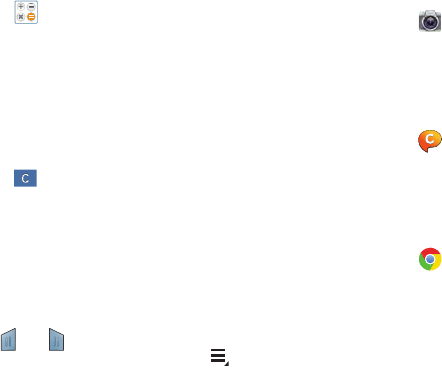
97
Calculator
The Calculator provides the basic arithmetic functions to
solve simple arithmetic problems and advanced operators to
solve more complex problems.
1. Touch
Calculator
.
2. Enter the first number using the numeric keys.
3. Enter the operation for your calculation by touching the
+
(add),
-
(subtract),
×
(multiply), or
÷
(divide) key.
4. Enter the next number.
5. To view the result, touch the
=
(equals) key.
6. Repeat Steps 3 through 5 as many times as required.
7. Touch to clear the result.
8. For more advanced problems, rotate your device to
landscape mode and use the advanced operators
sin
,
ln
,
cos
,
log
,
tan
, and so on, just as you would on a
pocket calculator.
9. Touch and hold entries in the Calculator's display field
to copy or cut the contents of the display.
The and displays. Use the icons to select the
content to Cut or Copy, and then select ➔
Clipboard
to review the Clipboard.
Camera
Take photos and record video with your device’s built in
Camera.
For more information, refer to “Camera” on page 69.
Touch
Camera
.
ChatON
Use ChatON to send and receive instant messages from any
device that has a mobile phone number.
For more information, refer to “ChatON” on page 53.
Touch
ChatON
.
Chrome
Use Chrome to browse the internet and bring your open tabs,
bookmarks and omnibox data from your computer to your
phone or tablet.
Touch
Chrome
.
Follow the on-screen instructions.

Applications 98
Contacts
Store contact information for your friends, family and
colleagues, to quickly access information or to send a
message.
For more information, refer to “Contacts” on page 40.
Touch
Contacts
.
Downloads
Files, apps, and other items you download in Internet, Gmail,
Email, or in other ways, are stored on your tablet’s internal
storage. Use the Downloads app to view, reopen, or delete
what you have downloaded.
1. Touch
Downloads
.
2. Touch an item to open it.
3. Touch headings for earlier downloads to view them.
4. Touch items you want to send, to check them, and then
touch
Share
. Touch an option to share the item.
5. Touch items you want to delete, to check them, and
then touch
Delete
.
The items are deleted from your tablet.
6. Touch
Sort by size
or
Sort by date
, at the bottom of the
Downloads pop-up, to switch back and forth. Touch
Clear list
to cancel the download and clear the
download history.
Dropbox
Dropbox provides access to your personal computer files
directly from your device. It allows you to take your files with
you when you are on the go, edit files in your Dropbox from
your device, upload photos and videos to Dropbox, and share
your selected files freely with family and friends.
The in-device application works together with a partner
program placed on a target computer using an active Internet
connection.
Dropbox creates a folder that automatically synchronizes its
contents across all of your connected devices on your
account. Update a file to your dropbox on your computer, and
it is automatically updated to the same folder on your other
devices.